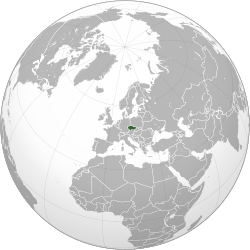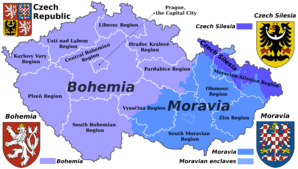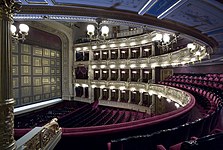Czech Republic
Czech Republic Česká republika(Czech) | |
|---|---|
| Motto: Pravda vítězí(Czech) "Truth prevails" | |
| Anthem: Kde domov můj(Czech) "Where My Home Is" | |
Location of the Czech Republic (dark green) – inEurope(green & dark gray) | |
| Capital and largest city | Prague 50°05′N14°28′E/ 50.083°N 14.467°E |
| Official language | Czech[1] |
| Ethnic groups (2021)[2] |
|
| Religion (2021)[3] |
|
| Demonym(s) | Czech |
| Government | Unitary parliamentary republic |
| Petr Pavel | |
| Petr Fiala | |
| Legislature | Parliament |
| Senate | |
| Chamber of Deputies | |
| Establishment | |
| c.870 | |
| 1198 | |
| 28 October 1918 | |
| 1 January 1993 | |
| Area | |
• Total | 78,871 km2(30,452 sq mi)[4](115th) |
• Water (%) | 2.16 (as of 2022)[4] |
| Population | |
• 2024 estimate | |
• 2021 census | |
• Density | 133/km2(344.5/sq mi) (91st) |
| GDP(PPP) | 2024 estimate |
• Total | |
• Per capita | |
| GDP(nominal) | 2024 estimate |
• Total | |
• Per capita | |
| Gini(2023) | low |
| HDI(2022) | very high(32nd) |
| Currency | Czech koruna(CZK) |
| Time zone | UTC+1(CET) |
• Summer (DST) | UTC+2(CEST) |
| Date format | d. m. yyyy |
| Driving side | right |
| Calling code | +420[a] |
| ISO 3166 code | CZ |
| Internet TLD | .cz[b] |
TheCzech Republic,[c][12]also known asCzechia,[d][13]is alandlocked countryinCentral Europe.Historically known asBohemia,[14]it is bordered byAustriato the south,Germanyto the west,Polandto the northeast, andSlovakiato the southeast.[15]The Czech Republic has a hilly landscape that covers an area of 78,871 square kilometers (30,452 sq mi) with a mostly temperatecontinentalandoceanic climate.The capital and largest city isPrague;other major cities and urban areas includeBrno,Ostrava,PlzeňandLiberec.
TheDuchy of Bohemiawas founded in the late 9th century underGreat Moravia.It was formally recognized as anImperial Stateof theHoly Roman Empirein 1002 and becamea kingdomin 1198.[16][17]Following theBattle of Mohácsin 1526, all of theCrown lands of Bohemiawere gradually integrated into theHabsburg monarchy.Nearly a hundred years later, theProtestantBohemian Revoltled to theThirty Years' War.After theBattle of White Mountain,the Habsburgs consolidated their rule. With the dissolution of the Holy Roman Empire in 1806, the Crown lands became part of theAustrian Empire.
In the 19th century, theCzech landsbecame more industrialized, and in 1918 most of it became part of theFirst Czechoslovak Republicfollowing the collapse ofAustria-HungaryafterWorld War I.[18]Czechoslovakia was the only country in Central and Eastern Europe to remain aparliamentary democracyduring the entirety of theinterwar period.[19]After theMunich Agreementin 1938,Nazi Germanysystematicallytook controlover the Czech lands.Czechoslovakiawas restored in 1945 and three years later became anEastern Bloccommuniststate following acoup d'étatin 1948. Attempts to liberalize the government and economy were suppressed by aSoviet-led invasion of the country during thePrague Springin 1968. In November 1989, theVelvet Revolutionended communist rule in the country and restoreddemocracy.On 31 December 1992,Czechoslovakia was peacefully dissolved,with its constituent states becoming the independent states of the Czech Republic and Slovakia.
The Czech Republic is aunitaryparliamentary republicanddeveloped countrywith anadvanced,high-incomesocial market economy.It is awelfare statewith aEuropean social model,universal health careandfree-tuitionuniversity education.It ranks 32nd in theHuman Development Index.The Czech Republic is a member of theUnited Nations,NATO,theEuropean Union,theOECD,theOSCE,theCouncil of Europeand theVisegrád Group.
Etymology
The traditional English name "Bohemia" derives fromLatin:Boiohaemum,which means "home of theBoii"(aGallictribe). The current English name ultimately comes from the Czech wordČech.[20][21][22]The name comes from the Slavic tribe (Czech:Češi, Čechové) and, according to legend, their leaderČech,who brought them to Bohemia, to settle onŘíp Mountain.The etymology of the wordČechcan be traced back to theProto-Slavicroot*čel-,meaning "member of the people; kinsman", thus making itcognateto the Czech wordčlověk(a person).[23]
The country has been traditionally divided into three lands, namelyBohemia(Čechy) in the west,Moravia(Morava) in the east, andCzech Silesia(Slezsko;the smaller, south-eastern part of historicalSilesia,most of which is located within modern Poland) in the northeast.[24]Known as thelands of the Bohemian Crownsince the 14th century, a number of other names for the country have been used, includingCzech/Bohemian lands,Bohemian Crown,Czechia,[25]and thelands of the Crown ofSaint Wenceslaus.When the country regained its independence after the dissolution of theAustro-Hungarian empirein 1918, the new name ofCzechoslovakiawas coined to reflect the union of the Czech and Slovak nations within one country.[26]
After Czechoslovakia dissolved on the last day of 1992,Českowas adopted as the Czech short name for the new state and theMinistry of Foreign Affairs of the Czech RepublicrecommendedCzechiafor the English-language equivalent.[27]This form was not widely adopted at the time, leading to the long nameCzech Republicbeing used in English in nearly all circumstances. The Czech governmentdirected use ofCzechiaas the official English short name in 2016.[28]The short name has been listed by theUnited Nations[29]and is used by other organizations such as theEuropean Union,[30]NATO,[31]theCIA,[32]Google Maps,[33]and theEuropean Broadcasting Union.[34]In 2022, the AmericanAP Stylebookstated in its entry on the country that "both [Czechia and the Czech Republic] are acceptable. The shorter name Czechia is preferred by the Czech government. If using Czechia, clarify in the story that the country is more widely known in English as the Czech Republic."[35]
History
Prehistory
Right:thestone head of a Celtis the most valuable Celtic sculpture in Europe and dates to the 3rd century BCE.[37]
Archaeologists have found evidence of prehistoric human settlements in the area, dating back to thePaleolithicera.[citation needed]
In theclassical era,as a result of the 3rd century BCCelticmigrations, Bohemia became associated with theBoii.[38]The Boii founded anoppidumnear the site of modern Prague.[39]Later in the 1st century, the Germanic tribes of theMarcomanniandQuadisettled there.[40]
Slavsfrom theBlack Sea–Carpathianregion settled in the area (their migration was pushed by an invasion of peoples fromSiberiaand Eastern Europe into their area:[41]Huns,Avars,BulgarsandMagyars).[42]In the sixth century, the Huns had moved westwards into Bohemia, Moravia, and some of present-day Austria and Germany.[42]
During the 7th century, the Frankish merchantSamo,supporting the Slavs fighting against nearby settledAvars,[43]became the ruler of the first documented Slavic state in Central Europe,Samo's Empire.The principality ofGreat Moravia,controlled byMoymir dynasty,arose in the 8th century.[44]It reached its zenith in the 9th (during the reign ofSvatopluk I of Moravia), holding off the influence of the Franks. Great Moravia was Christianized, with a role being played by theByzantinemission ofCyril and Methodius.They codified theOld Church Slavoniclanguage, the first literary and liturgical language of theSlavs,and theGlagolitic script.[45]
Bohemia
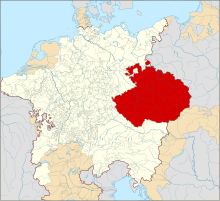
TheDuchy of Bohemiaemerged in the late 9th century when it was unified by thePřemyslid dynasty.Bohemia was from 1002 until 1806 anImperial Estateof theHoly Roman Empire.[46]
In 1212,Přemysl Ottokar Iextracted theGolden Bull of Sicilyfrom the emperor, confirming Ottokar and his descendants' royal status; theDuchyof Bohemia was raised to aKingdom.[47]German immigrantssettled in the Bohemian periphery in the 13th century.[48]TheMongolsin theinvasion of Europecarried their raids intoMoraviabut were defensively defeated atOlomouc.[49]
After a series of dynastic wars, theHouse of Luxembourggained the Bohemian throne.[50]
Efforts for areform of the church in Bohemiastarted already in the late 14th century.Jan Hus' followers seceded from some practices of theRoman Churchand in theHussite Wars(1419–1434) defeated five crusades organized against them bySigismund.During the next two centuries, 90% of the population in Bohemia and Moravia were consideredHussites.The pacifist thinkerPetr Chelčickýinspired the movement of theMoravian Brethren(by the middle of the 15th century) that completely separated from the Roman Catholic Church.[51]
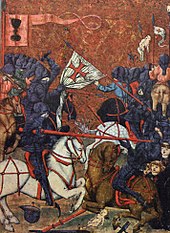
On 21 December 1421,Jan Žižka,a successful military commander and mercenary, led his group of forces in theBattle of Kutná Hora,resulting in a victory for the Hussites. He is honoured to this day as anational hero.
After 1526 Bohemia came increasingly underHabsburgcontrol as the Habsburgs became first the elected and then in 1627 the hereditary rulers of Bohemia. Between 1583 and 1611 Prague was the official seat of the Holy Roman EmperorRudolf IIand his court.
TheDefenestration of Pragueand subsequent revolt against the Habsburgs in 1618 marked the start of theThirty Years' War.In 1620, the rebellion in Bohemia was crushed at theBattle of White Mountainand the ties between Bohemia and the Habsburgs' hereditary lands in Austria were strengthened. The leaders of theBohemian Revoltwereexecuted in 1621.The nobility and the middle class Protestants had to either convert to Catholicism or leave the country.[52]
The following era of 1620 to the late 18th century became known as the "Dark Age". During the Thirty Years' War, the population of theCzech landsdeclined by a third through the expulsion of Czech Protestants as well as due to the war, disease andfamine.[53]The Habsburgs prohibited all Christian confessions other thanCatholicism.[54]The flowering ofBaroque cultureshows the ambiguity of this historical period. Ottoman TurksandTatarsinvaded Moravia in 1663.[55]In 1679–1680 the Czech lands faced theGreat Plague of Viennaand an uprising of serfs.[56]

There were peasant uprisings influenced by famine.[57]Serfdomwas abolished between 1781 and 1848. Several battles of theNapoleonic Warstook place on the current territory of the Czech Republic.
The end of theHoly Roman Empirein 1806 led to degradation of the political status of Bohemia which lost its position of anelectorateof the Holy Roman Empire as well as its own political representation in theImperial Diet.[58]Bohemian lands became part of theAustrian Empire.During the 18th and 19th century theCzech National Revivalbegan its rise, with the purpose to reviveCzech language,culture, and national identity. TheRevolution of 1848in Prague, striving for liberal reforms and autonomy of the Bohemian Crown within the Austrian Empire, was suppressed.[59]
It seemed that some concessions would be made also to Bohemia, but in the end, the EmperorFranz Joseph Iaffected a compromise with Hungary only. TheAustro-Hungarian Compromise of 1867and the never realized coronation of Franz Joseph as King of Bohemia led to a disappointment of some Czech politicians.[59]The Bohemian Crown lands became part of the so-calledCisleithania.
The Czech Social Democratic and progressive politicians started the fight for universal suffrage. The first elections underuniversal male suffragewere held in 1907.[60]
Czechoslovakia
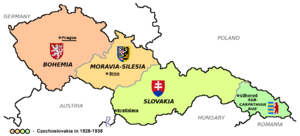
In 1918, during the collapse of theHabsburg monarchyat the end of World War I, the independent republic ofCzechoslovakia,which joined the winning Allied powers, was created, withTomáš Garrigue Masarykin the lead.[62]This new country incorporated theBohemian Crown.[63]
TheFirst Czechoslovak Republiccomprised only 27% of the population of the former Austria-Hungary, but nearly 80% of the industry, which enabled it to compete with Western industrial states.[61]In 1929 compared to 1913, the gross domestic product increased by 52% and industrial production by 41%. In 1938 Czechoslovakia held 10th place in the world industrial production.[64]Czechoslovakia was the only country in Central and Eastern Europe to remain a liberal democracy throughout the entire interwar period.[65]Although the First Czechoslovak Republic was aunitary state,it provided certain rights to its minorities, the largest beingGermans(23.6% in 1921), Hungarians (5.6%) and Ukrainians (3.5%).[66]

Western Czechoslovakia wasoccupied by Nazi Germany,which placed most of the region into theProtectorate of Bohemia and Moravia.The Protectorate was proclaimed part of the Third Reich, and the president and prime minister were subordinated to Nazi Germany'sReichsprotektor.One Nazi concentration campwas located within the Czech territory atTerezín,north of Prague. The vast majority of the Protectorate's Jews were murdered inNazi-run concentration camps.The NaziGeneralplan Ostcalled for the extermination, expulsion,Germanizationor enslavement of most or all Czechs for the purpose of providing moreliving spacefor the German people.[67]There wasCzechoslovak resistance to Nazi occupationas well as reprisals against the Czechoslovaks for their anti-Nazi resistance. The German occupation ended on 9 May 1945, with the arrival of the Soviet and American armies and thePrague uprising.[68]Most of Czechoslovakia's German-speakers were forcibly expelled from the country, first as a result of local acts of violence and then under the aegis of an "organized transfer" confirmed by the Soviet Union, the United States, and Great Britain at thePotsdam Conference.[69]
In the1946 elections,theCommunist Partygained 38%[70]of the votes and became the largest party in the Czechoslovak parliament, formed a coalition with other parties, and consolidated power. Acoup d'étatcame in 1948 and a single-party government was formed. For thenext 41 years,the Czechoslovak Communist state conformed toEastern Bloceconomic and political features.[71]ThePrague Springpolitical liberalization was stopped by the 1968Warsaw Pact invasion of Czechoslovakia.Analysts believe that the invasion caused the communist movement to fracture, ultimately leading to the Revolutions of 1989.
Czech Republic
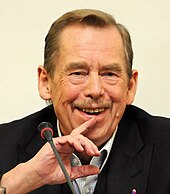
In November 1989, Czechoslovakia again became a liberal democracy through theVelvet Revolution.However, Slovak national aspirations strengthened (Hyphen War) and on 31 December 1992, thecountry peacefully splitinto the independentcountriesof the Czech Republic andSlovakia.Both countries went through economic reforms andprivatizations,with the intention of creating amarket economy,as they have been trying to do since 1990, when Czechs and Slovaks still shared the common state. This process was largely successful; in 2006 the Czech Republic was recognized by the World Bank as a "developed country",[72]and in 2009 theHuman Development Indexranked it as a nation of "Very High Human Development".[73]
From 1991, the Czech Republic, originally as part of Czechoslovakia and since 1993 in its own right, has been a member of theVisegrád Groupand from 1995, theOECD.The Czech Republic joinedNATOon 12 March 1999 and theEuropean Unionon 1 May 2004. On 21 December 2007 the Czech Republic joined theSchengen Area.[74]
Until 2017, either the centre-leftCzech Social Democratic Partyor the centre-rightCivic Democratic Partyled the governments of the Czech Republic. In October 2017, the populist movementANO 2011,led by the country's second-richest man,Andrej Babiš,won theelectionswith three times more votes than its closest rival, the Civic Democrats.[75]In December 2017, Czech presidentMiloš Zemanappointed Andrej Babiš as the new prime minister.[76]
In the2021 elections,ANO 2011was narrowly defeated andPetr Fialabecame the new prime minister.[77]He formed a government coalition of the allianceSPOLU(Civic Democratic Party,KDU-ČSLandTOP 09) and the alliance ofPirates and Mayors.In January 2023, retired generalPetr Pavelwon thepresidential election,becoming new Czech president to succeed Miloš Zeman.[78]Following the2022 Russian invasion of Ukraine,the country took in half a millionUkrainian refugees,the largest number per capita in the world.[79][80]
Geography

The Czech Republic lies mostly between latitudes48°and51° Nand longitudes12°and19° E.
Bohemia,to the west, consists of a basin drained by theElbe(Czech:Labe) and theVltavarivers, surrounded by mostly low mountains, such as theKrkonošerange of theSudetes.The highest point in the country,Sněžkaat 1,603 m (5,259 ft), is located here. Moravia, the eastern part of the country, is also hilly. It is drained mainly by theMorava River,but it also contains the source of theOderRiver (Czech:Odra).
Water from the Czech Republic flows to three different seas: theNorth Sea,Baltic Sea,andBlack Sea.The Czech Republic also leases theMoldauhafen,a 30,000-square-meter (7.4-acre)lotin the middle of theHamburgDocks, which was awarded to Czechoslovakia by Article 363 of theTreaty of Versailles,to allow the landlocked country a place where goods transported down river could be transferred to seagoing ships. The territory reverts to Germany in 2028.
Phytogeographically,the Czech Republic belongs to the Central European province of theCircumboreal Region,within theBoreal Kingdom.According to theWorld Wide Fund for Nature,the territory of the Czech Republic can be subdivided into fourecoregions:theWestern European broadleaf forests,Central European mixed forests,Pannonian mixed forests,andCarpathian montane conifer forests.[81]
There are fournational parksin the Czech Republic. The oldest isKrkonoše National Park(Biosphere Reserve), and the others areŠumava National Park(Biosphere Reserve),Podyjí National Park,andBohemian Switzerland.
The three historical lands of the Czech Republic (formerly some countries of the Bohemian Crown) correspond with the river basins of the Elbe and the Vltava basin for Bohemia, the Morava one for Moravia, and the Oder river basin for Czech Silesia (in terms of the Czech territory).
Climate

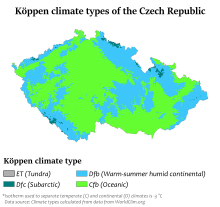
The Czech Republic has a temperate climate, situated in the transition zone between theoceanicandcontinental climatetypes, with warm summers and cold, cloudy and snowy winters. The temperature difference between summer and winter is due to the landlocked geographical position.[82]
Temperatures vary depending on the elevation. In general, at higher altitudes, the temperatures decrease andprecipitationincreases. The wettest area in the Czech Republic is found aroundBílý PotokinJizera Mountainsand the driest region is theLouny Districtto the northwest ofPrague.Another factor is the distribution of the mountains.
At the highest peak ofSněžka(1,603 m or 5,259 ft), the average temperature is −0.4 °C (31 °F), whereas in the lowlands of theSouth Moravian Region,the average temperature is as high as 10 °C (50 °F). The country's capital, Prague, has a similar average temperature, although this is influenced by urban factors.
The coldest month is usually January, followed by February and December. During these months, there issnowin the mountains and sometimes in the cities and lowlands. During March, April, and May, the temperature usually increases, especially during April, when the temperature and weather tends to vary during the day. Spring is also characterized by higher water levels in the rivers, due to melting snow with occasional flooding.
The warmest month of the year is July, followed by August and June. On average, summer temperatures are about 20–30 °C (36–54 °F) higher than during winter. Summer is also characterized by rain and storms.
Autumn generally begins in September, which is still warm and dry. During October, temperatures usually fall below 15 °C (59 °F) or 10 °C (50 °F) anddeciduoustrees begin to shed their leaves. By the end of November, temperatures usually range around the freezing point.
The coldest temperature ever measured was inLitvínovicenearČeské Budějovicein 1929, at −42.2 °C (−44.0 °F) and the hottest measured, was at 40.4 °C (104.7 °F) inDobřichovicein 2012.[83]
Mostrainfalls during the summer. Sporadic rainfall is throughout the year (in Prague, the average number of days per month experiencing at least 0.1 mm (0.0039 in) of rain varies from 12 in September and October to 16 in November) but concentrated rainfall (days with more than 10 mm (0.39 in) per day) are more frequent in the months of May to August (average around two such days per month).[84]Severethunderstorms,producing damaging straight-line winds,hail,and occasionaltornadoesoccur, especially during the summer period.[85][86]
Environment
As of 2020, the Czech Republic ranks as the 21st most environmentally conscious country in the world inEnvironmental Performance Index.[87]It had a 2018Forest Landscape Integrity Indexmean score of 1.71/10, ranking it 160th globally out of 172 countries.[88]The Czech Republic has four National Parks (Šumava National Park,Krkonoše National Park,České Švýcarsko National Park,Podyjí National Park) and 25 Protected Landscape Areas.
Government
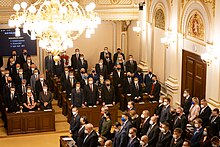
The Czech Republic is a pluralist multi-partyparliamentaryrepresentative democracy.TheParliament(Parlament České republiky) is bicameral, with theChamber of Deputies(Czech:Poslanecká sněmovna,200 members) and theSenate(Czech:Senát,81 members).[89]Themembers of the Chamber of Deputiesare elected for a four-year term byproportional representation,with a 5%election threshold.There are 14 voting districts, identical to the country's administrative regions. The Chamber of Deputies, the successor to theCzech National Council,has the powers and responsibilities of the now defunct federal parliament of the former Czechoslovakia. The members of the Senate are elected in single-seatconstituenciesby two-roundrunoff votingfor a six-year term, with one-third elected every even year in the autumn. This arrangement is modeled on theU.S. Senate,but each constituency is roughly the same size and the voting system used is a two-round runoff.
The president is a formal head of state with limited and specific powers, who appoints the prime minister, as well the other members of the cabinet on a proposal by the prime minister. From 1993 until 2012, thePresident of the Czech Republicwas selected by a joint session of the parliament for a five-year term, with no more than two consecutive terms (Václav HavelandVáclav Klauswere both elected twice). Since 2013, the president has been elected directly.[90]Some commentators have argued that, with the introduction of direct election of the President, the Czech Republic has moved away from the parliamentary system and towards asemi-presidentialone.[91]TheGovernment's exercise of executive power derives from theConstitution.The members of the government are thePrime Minister,Deputy prime ministers and other ministers. The Government is responsible to theChamber of Deputies.[92]ThePrime Ministeris the head of government and wields powers such as the right to set the agenda for most foreign and domestic policy and choose government ministers.[93]
| Office | Name | Party | Since |
|---|---|---|---|
| President | Petr Pavel | Independent | 9 March 2023 |
| President of the Senate | Miloš Vystrčil | ODS | 19 February 2020 |
| President of the Chamber of Deputies | Markéta Pekarová Adamová | TOP 09 | 10 November 2021 |
| Prime Minister | Petr Fiala | ODS | 28 November 2021 |
Law

The Czech Republic is aunitary state,[94]with acivil law systembased on the continental type, rooted in Germanic legal culture. The basis of the legal system is theConstitution of the Czech Republicadopted in 1993.[95]ThePenal Codeis effective from 2010. A newCivil codebecame effective in 2014. The court system includes district, county, and supreme courts and is divided into civil, criminal, and administrative branches. The Czech judiciary has atriumvirateof supreme courts. TheConstitutional Courtconsists of 15 constitutional judges and oversees violations of theConstitutionby either the legislature or by thegovernment.[95]TheSupreme Courtis formed of 67 judges and is the court of highest appeal for mostlegal casesheard in the Czech Republic. TheSupreme Administrative Courtdecides on issues of procedural and administrative propriety. It also has jurisdiction over certain political matters, such as the formation and closure of political parties, jurisdictional boundaries between government entities, and the eligibility of persons to stand for public office.[95]The Supreme Court and the Supreme Administrative Court are both based inBrno,as is the Supreme Public Prosecutor's Office.[95]
Foreign relations

The Czech Republic has ranked asone of the safest or most peaceful countriesfor the past few decades.[96]It is a member of the United Nations, theEuropean Union,NATO,OECD,Council of Europeand is an observer to theOrganization of American States.[97]The embassies of most countries with diplomatic relations with the Czech Republic are located inPrague,whileconsulatesare located across the country.
The Czech passport isrestricted by visas.According to the 2018Henley & Partners Visa Restrictions Index,Czech citizens have visa-free access to 173 countries, which ranks them 7th along withMaltaandNew Zealand.[98]TheWorld Tourism Organizationranks the Czech passport 24th.[99]The USVisa Waiver Programapplies to Czech nationals.

ThePrime MinisterandMinister of Foreign Affairshave primary roles in setting foreign policy, although thePresidentalso has influence and represents the country abroad. Membership in the European Union and NATO is central to the Czech Republic's foreign policy. TheOffice for Foreign Relations and Information(ÚZSI) serves as theforeign intelligenceagency responsible forespionageand foreign policy briefings, as well as protection of Czech Republic's embassies abroad.
The Czech Republic has ties withSlovakia,PolandandHungaryas a member of theVisegrád Group,[100]as well as with Germany,[101]Israel,[102]the United States[103]and theEuropean Unionand itsmembers.After 2020, relations with Asian democratic states, such asTaiwan,are being strengthened.[104]Conversely, the Czech Republic has long had bad relations withRussia,and from 2021 the Czech Republic appears on Russia's official list of enemy countries.[105]The Czech Republic also has problematic relations withChina.
Czech officials have supported dissenters inBelarus,Moldova,MyanmarandCuba.[106]
Famous Czech diplomats of the past includedJaroslav Lev of Rožmitál,Humprecht Jan Czernin,CountPhilip Kinsky of Wchinitz and Tettau,Wenzel Anton, Prince of Kaunitz-Rietberg,PrinceKarl Philipp Schwarzenberg,Alois Lexa von Aehrenthal,Ottokar Czernin,Edvard Beneš,Jan Masaryk,Jiří Hájek,Jiří Dienstbier,Michael Žantovský,Petr Kolář,Alexandr Vondra,PrinceKarel SchwarzenbergandPetr Pavel.
Military
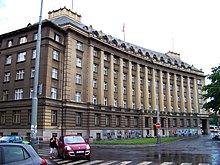
TheCzech armed forcesconsist of theCzech Land Forces,theCzech Air Forceand of specialized support units. The armed forces are managed by theMinistry of Defence.ThePresident of the Czech RepublicisCommander-in-chiefof the armed forces. In 2004 the army transformed itself into a fully professional organization and compulsory military service was abolished. The country has been a member ofNATOsince 12 March 1999. Defence spending is approximately 1.28% of the GDP (2021).[107]The armed forces are charged with protecting the Czech Republic and its allies, promoting global security interests, and contributing to NATO.
Currently, as a member of NATO, the Czech military are participating in theResolute SupportandKFORoperations and have soldiers inAfghanistan,Mali,Bosnia and Herzegovina,Kosovo,Egypt,IsraelandSomalia.The Czech Air Force also served in theBaltic statesandIceland.[108]The main equipment of the Czech military includesJAS 39 Gripenmulti-role fighters,Aero L-159 Alcacombat aircraft,Mi-35attack helicopters, armored vehicles (Pandur II,OT-64,OT-90,BVP-2) and tanks (T-72andT-72M4CZ).
Human rights
Human rights in the Czech Republic are guaranteed by theCharter of Fundamental Rights and Freedomsandinternational treatieson human rights. Nevertheless, there were cases of human rights violations such as discrimination against Roma children,[109]for which theEuropean Commissionasked the Czech Republic to provide an explanation,[110]or the illegal sterilization of Roma women,[111]for which the government apologized.[112]
People of the same sex can enter into a "registered partnership"in the Czech Republic. Conductingsame-sex marriageis not legal under current Czech law.[113]
Administrative divisions
Since 2000, the Czech Republic has been divided intothirteen regions(Czech:kraje,singularkraj) and the capital city ofPrague.Every region has its own elected regional assembly and a regional governor. In Prague, the assembly and presidential powers are executed by the city council and the mayor.
The older seventy-sixdistricts(okresy,singularokres) including three "statutory cities" (without Prague, which had special status) lost most of their importance in 1999 in an administrative reform; they remain as territorial divisions and seats of various branches of state administration.[114]
The smallest administrative units areobce(municipalities).As of 2021, the Czech Republic is divided into 6,254 municipalities. Cities and towns are also municipalities. The capital city of Prague is a region and municipality at the same time.
Economy
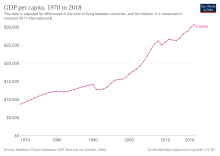
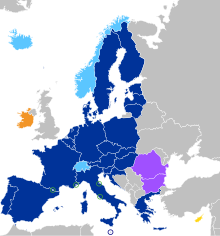
The Czech Republic has adeveloped,[115]high-income[116]export-orientedsocial market economybased in services, manufacturing and innovation, that maintains awelfare stateand theEuropean social model.[117]The Czech Republic participates in theEuropean Single Marketas a member of theEuropean Unionand is therefore a part of theeconomy of the European Union,but uses its own currency, theCzech koruna,instead of theeuro.It has a per capita GDP rate that is 91% of the EU average[118]and is a member of theOECD.Monetary policyis conducted by theCzech National Bank,whose independence is guaranteed by theConstitution.The Czech Republic ranks 12th in theUNinequality-adjusted human developmentand 24th inWorld Bank Human Capital Index.It was described byThe Guardianas "one of Europe's most flourishing economies".[119]
As of 2023[update],the country'sGDP per capitaatpurchasing power parityis $51,329[120]and $29,856 atnominal value.[121]According to Allianz A.G., in 2018 the country was an MWC (mean wealth country), ranking 26th in net financial assets.[122]The country experienced a 4.5%GDP growthin 2017.[123]The 2016unemploymentrate was the lowest in the EU at 2.4%,[124]and the 2016 poverty rate was the second lowest of OECD members.[125]Czech Republic ranks 27th in the 2021Index of Economic Freedom,[126]31st in the 2023Global Innovation Index,down from 24th in the 2016,[127][128]29th in theGlobal Competitiveness Report,[129]and 25th in theGlobal Enabling Trade Report.[130] The Czech Republic has a diverse economy thatranks 7thin the 2016Economic Complexity Index.[131]The industrial sector accounts for 37.5% of the economy, while services account for 60% and agriculture for 2.5%.[132]The largest trading partner for both export and import isGermanyand the EU in general. Dividends worth CZK 270 billion were paid to theforeign ownersof Czech companies in 2017, which has become a political issue.[133]The country has been a member of theSchengen Areasince 1 May 2004, having abolished border controls, completely opening its borders with all of its neighbors on 21 December 2007.[134]
Industry

In 2018[update]thelargest companiesby revenue in the Czech Republic were: automobile manufacturerŠkoda Auto,utility companyČEZ Group,conglomerateAgrofert,energy trading companyEPH,oil processing companyUnipetrol,electronics manufacturerFoxconn CZand steel producerMoravia Steel.[135]Other Czech transportation companies include:Škoda Transportation(tramways, trolleybuses, metro),Tatra(heavy trucks, the second oldest car maker in the world),Avia(medium trucks),KarosaandSOR Libchavy(buses),Aero Vodochody(military aircraft),Let Kunovice(civil aircraft),Zetor(tractors),Jawa Moto(motorcycles) andČezeta(electric scooters).
Škoda Transportation is the fourth largesttramproducer in the world; nearly one third of all trams in the world come from Czech factories.[136]The Czech Republic is also the world's largestvinyl recordsmanufacturer, withGZ Mediaproducing about 6 million pieces annually inLoděnice.[137]Česká zbrojovkais among the ten largestfirearmsproducers in the world and five who produce automatic weapons.[138]
In thefood industry,Czech companies includeAgrofert,KofolaandHamé.
Energy

Production of Czech electricity exceeds consumption by about 10TWhper year, the excess being exported.Nuclear powerpresently provides about 30 percent of the total power needs, its share is projected to increase to 40 percent. In 2005, 65.4 percent of electricity was produced by steam and combustion power plants (mostly coal); 30 percent by nuclear plants; and 4.6 percent came from renewable sources, including hydropower. The largest Czech power resource isTemelín Nuclear Power Station,with another nuclear power plant inDukovany.
The Czech Republic is reducing its dependence on highly polluting low-gradebrown coalas a source of energy. Natural gas is purchased fromNorwegiancompanies and as liquefied gas LNG from theNetherlandsandBelgium.In the past, three-quarters of gas supplies came fromRussia,but after the outbreak of thewar in Ukraine,the government gradually stopped these supplies.[139]Gas consumption (approx. 100 TWh in 2003–2005) is almost double electricity consumption. South Moravia has smalloil and gas deposits.
Transportation infrastructure

As of 2020,[update]the road network in the Czech Republic is 55,768.3 kilometers (34,652.82 mi) long, out of which 1,276.4 km (793.1 mi) are motorways.[140]Thespeed limitis 50 km/h (31 mph) within towns, 90 km/h (56 mph) outside of towns and 130 km/h (81 mph) on motorways.[141]
The Czech Republic has one of thedensest rail networks in the world.As of 2020,[update]the country has 9,542 kilometers (5,929 mi) of lines. Of that number, 3,236 km (2,011 mi) is electrified, 7,503 km (4,662 mi) are single-line tracks and 2,040 km (1,270 mi) are double and multiple-line tracks.[142]The length of tracks is 15,360 km (9,540 mi), out of which 6,917 km (4,298 mi) is electrified.[143]
České dráhy(the Czech Railways) is the main railway operator in the country, with about 180 million passengers carried yearly. Maximum speed is limited to 160 km/h (99 mph).
Václav Havel Airportin Prague is the main international airport in the country. In 2019, it handled 17.8 million passengers.[144]In total, the Czech Republic has91 airports,six of which provide international air services. The public international airports are inBrno,Karlovy Vary,Mnichovo Hradiště,Mošnov(nearOstrava),Pardubiceand Prague.[145]The non-public international airports capable of handling airliners are inKunoviceandVodochody.[146]
Russia, via pipelines through Ukraine and to a lesser extent, Norway, via pipelines through Germany, supply the Czech Republic with liquid and natural gas.[147]
Communications and IT

The Czech Republic ranks in the top 10 countries worldwide with the fastest average internet speed.[148]By the beginning of 2008, there were over 800 mostly localWISPs,[149][150]with about 350,000 subscribers in 2007. Plans based on eitherGPRS,EDGE,UMTSorCDMA2000are being offered by all three mobile phone operators (T-Mobile,O2,Vodafone) and internet provider U:fon. Government-ownedČeský Telecomslowed down broadband penetration. At the beginning of 2004,local-loop unbundlingbegan and alternative operators started to offerADSLand alsoSDSL.This and later privatization of Český Telecom helped drive down prices.
On 1 July 2006, Český Telecom was acquired by globalized company (Spain-owned) Telefónica group and adopted the new nameTelefónica O2 Czech Republic.As of 2017[update],VDSL and ADSL2+ are offered in variants, with download speeds of up to 50 Mbit/s and upload speeds of up to 5 Mbit/s. Cable internet is gaining more popularity with its higher download speeds ranging from 50 Mbit/s to 1 Gbit/s.
Twocomputer securitycompanies,AvastandAVG,were founded in the Czech Republic. In 2016, Avast led byPavel Baudišbought rival AVG forUS$1.3 billion, together at the time, these companies had a user base of about 400 million people and 40% of the consumer market outside of China.[151][152]Avast is the leading provider of antivirus software, with a 20.5% market share.[153]
Tourism

Pragueis the fifth most visited city in Europe after London, Paris, Istanbul and Rome.[154]In 2001, the total earnings from tourism reached 118 billionCZK,making up 5.5% of the country'sGNPand 9% of its overall export earnings. The industry employs more than 110,000 people – over 1% of the population.[155] Guidebooks and tourists reporting overcharging by taxi drivers and pickpocketing problems talk mainly about Prague, though the situation has improved recently.[156][157]Since 2005, Prague's mayor,Pavel Bém,has worked to improve this reputation by cracking down on petty crime[157]and, aside from these problems, Prague is a "safe" city.[158]The Czech Republic's crime rate is described by the United States State department as "low".[159]
The Czech Republic boasts17 UNESCO World Heritage Sites,3 of them being transnational. As of 2024[update],further 13 sites are on the tentative list.[160]
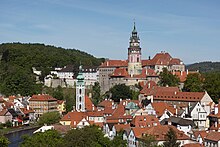
Architectural heritage is an object of interest to visitors – it includescastles and châteauxfrom different historical epochs, namelyKarlštejnCastle,Český Krumlovand theLednice–Valtice Cultural Landscape.There are 12cathedralsand 15 churches elevated to the rank ofbasilicaby the Pope, as well as many monasteries.
Away from the towns, areas such asBohemian Paradise,Bohemian Forestand theGiant Mountainsattract visitors seeking outdoor pursuits.
The country is also known for its variousmuseums,puppetryandmarionetteexhibitions that take part within larger puppetfestivals,andbeer festivals.[161]Aquapalace PragueinČestliceis the largestwater parkin the country.
Science
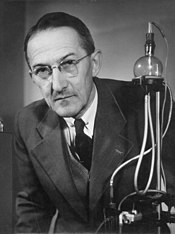
The Czech lands have a long and well-documented history of scientific innovation.[162][163]Today, the Czech Republic has a highly sophisticated, developed, high-performing, innovation-oriented scientific community supported by the government,[164]industry,[165]and leadinguniversities.[166]Czech scientists are embedded members of the global scientific community.[167]They contribute annually to multiple international academic journals and collaborate with their colleagues across boundaries and fields.[168][169][170][171]The Czech Republic was ranked 24th in theGlobal Innovation Indexin 2020 and 2021, up from 26th in 2019.[172][173][174]
Historically, the Czech lands, especiallyPrague,have been the seat of scientific discovery going back to early modern times, includingTycho Brahe,Nicolaus Copernicus,andJohannes Kepler.In 1784 the scientific community was first formally organized under the charter of theRoyal Czech Society of Sciences.Currently, this organization is known as theCzech Academy of Sciences.[175]Similarly, the Czech lands have a well-established history of scientists,[176][177]including Nobel laureates biochemistsGertyandCarl Ferdinand Cori,chemistsJaroslav HeyrovskýandOtto Wichterle,physicistsErnst MachandPeter Grünberg,physiologistJan Evangelista Purkyněand chemistAntonín Holý.[178]Sigmund Freud,the founder ofpsychoanalysis,was born inPříbor,[179]Gregor Mendel,the founder ofgenetics,was born inHynčiceand spent most of his life inBrno,[180]logician and mathematicianKurt Gödelwas born in Brno.

Historically, most scientific research was recorded in Latin, but from the 18th century onwards increasingly in German and later in Czech, archived in libraries supported and managed by religious groups and other denominations as evidenced by historical locations of international renown and heritage such as theStrahov Monasteryand theClementinuminPrague.Increasingly, Czech scientists publish their work and that of their history in English.[181][182]
The current important scientific institution is the already mentionedAcademy of Sciences of the Czech Republic,theCEITECInstitute inBrnoor theHiLASEandEli Beamlinescenters with the most powerful laser in the world inDolní Břežany.Prague is the seat of the administrative center of the GSA Agency operating the European navigation systemGalileoand theEuropean Union Agency for the Space Programme.
Demographics
Thetotal fertility rate(TFR) in 2020 was estimated at 1.71 children per woman, which is below the replacement rate of 2.1.[183]The Czech Republic's population has an average age of 43.3 years.[184]The life expectancy in 2021 was estimated to be 79.5 years (76.55 years male, 82.61 years female).[185]About 77,000 people immigrate to the Czech Republic annually.[186]Vietnameseimmigrants began settling in the country during the Communist period, when they were invited asguest workersby the Czechoslovak government.[187]In 2009, there were about 70,000 Vietnamese in the Czech Republic.[188]Most decide to stay in the country permanently.[189]
According to results of the 2021 census, the majority of the inhabitants of the Czech Republic areCzechs(57.3%), followed byMoravians(3.4%),Slovaks(0.9%),Ukrainians(0.7%),Viets(0.3%),Poles(0.3%),Russians(0.2%),Silesians(0.1%) andGermans(0.1%). Another 4.0% declared combination of two nationalities (3.6% combination of Czech and other nationality). As the 'nationality' was an optional item, a number of people left this field blank (31.6%).[2]According to some estimates, there are about 250,000Romani peoplein the Czech Republic.[190][191]ThePolish minorityresides mainly in theTrans-Olzaregion.[192]
There were 658,564 foreigners residing in the country in 2021,[193]according to theCzech Statistical Office,with the largest groups beingUkrainian(22%),Slovak(22%),Vietnamese(12%),Russian(7%) andGerman(4%). Most of the foreign population lives in Prague (37.3%) and Central Bohemia Region (13.2%).[194]
TheJewishpopulation of Bohemia and Moravia, 118,000 according to the 1930 census, was nearly annihilated by the Nazi Germans duringthe Holocaust.[195]There were approximately 3,900 Jews in the Czech Republic in 2021.[196]The former Czech prime minister,Jan Fischer,is of Jewish faith.[197]
Nationality of residents, who answered the question in the Census 2021:[198][199]
| Nationality | Share |
|---|---|
| Czech | 83.76% |
| Moravian | 4.99% |
| Czech and Moravian | 2.50% |
| Slovak | 1.33% |
| Ukrainian | 1.08% |
| Czech and Slovak | 0.82% |
| Vietnamese | 0.44% |
| Polish | 0.37% |
| Russian | 0.35% |
| Other | 4.36% |
Largest cities
| Rank | Name | Region | Pop. | Rank | Name | Region | Pop. | ||
|---|---|---|---|---|---|---|---|---|---|
 Prague  Brno |
1 | Prague | Prague | 1,357,326 | 11 | Zlín | Zlín | 74,191 |  Ostrava  Plzeň |
| 2 | Brno | South Moravian | 396,101 | 12 | Havířov | Moravian-Silesian | 70,245 | ||
| 3 | Ostrava | Moravian-Silesian | 283,504 | 13 | Kladno | Central Bohemian | 68,436 | ||
| 4 | Plzeň | Plzeň | 181,240 | 14 | Most | Ústí nad Labem | 63,856 | ||
| 5 | Liberec | Liberec | 107,389 | 15 | Opava | Moravian-Silesian | 55,512 | ||
| 6 | Olomouc | Olomouc | 101,825 | 16 | Frýdek-Místek | Moravian-Silesian | 54,188 | ||
| 7 | České Budějovice | South Bohemian | 96,417 | 17 | Jihlava | Vysočina | 52,548 | ||
| 8 | Hradec Králové | Hradec Králové | 93,506 | 18 | Teplice | Ústí nad Labem | 50,843 | ||
| 9 | Pardubice | Pardubice | 92,149 | 19 | Karviná | Moravian-Silesian | 50,172 | ||
| 10 | Ústí nad Labem | Ústí nad Labem | 91,963 | 20 | Karlovy Vary | Karlovy Vary | 49,043 | ||
Religion
About 75%[202]to 79%[203]of residents of the Czech Republic do not declare having any religion or faith in surveys, and the proportion of convincedatheists(30%) is the third highest in the world behind those ofChina(47%) andJapan(31%).[204][unreliable source?]TheCzech peoplehave been historically characterized as "tolerant and even indifferent towards religion".[205]The religious identity of the country has changed drastically since the first half of the 20th century, when more than 90% ofCzechswere Christians.[206]
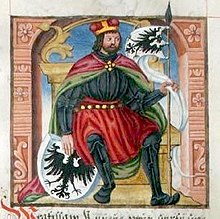
Christianization in the 9th and 10th centuries introducedCatholicism.After theBohemian Reformation,most Czechs becamefollowersofJan Hus,Petr Chelčickýand other regionalProtestant Reformers.TaboritesandUtraquistswereHussitegroups. Towards the end of theHussite Wars,the Utraquists changed sides and allied with the Catholic Church. Following the joint Utraquist—Catholic victory, Utraquism was accepted as a distinct form of Christianity to be practiced inBohemiaby theCatholic Churchwhile all remaining Hussite groups were prohibited. After theReformation,some Bohemians went with theteachings of Martin Luther,especiallySudeten Germans.In the wake of the Reformation, Utraquist Hussites took a renewed increasinglyanti-Catholicstance, while some of the defeated Hussite factions were revived. After theHabsburgsregained control of Bohemia, the whole population was forcibly converted to Catholicism—even the Utraquist Hussites. Going forward, Czechs have become more wary and pessimistic of religion as such. A history of resistance to the Catholic Church followed. It suffered a schism with the neo-HussiteCzechoslovak Hussite Churchin 1920, lost the bulk of its adherents during the Communist era and continues to lose in the modern, ongoingsecularization.Protestantism never recovered after theCounter-Reformationwas introduced by theAustrian Habsburgsin 1620. Prior to the Holocaust, the Czech Republic had a sizable Jewish community of around 100,000. There are many historically important and culturally relevant Synagogues in the Czech Republic such as Europe's oldest active Synagogue,The Old New Synagogueand the second largest Synagogue in Europe, theGreat Synagogue (Plzeň).The Holocaust decimated Czech Jewry and the Jewish population as of 2021 is 3,900.[207]
According to the 2011 census, 34% of the population stated they had no religion, 10.3% was Catholic, 0.8% wasProtestant(0.5%Czech Brethrenand 0.4%Hussite),[208]and 9% followed other forms of religion both denominational or not (of which 863 people answered they arePagan). 45% of the population did not answer the question about religion.[201]From 1991 to 2001 and further to 2011 the adherence to Catholicism decreased from 39% to 27% and then to 10%; Protestantism similarly declined from 3.7% to 2% and then to 0.8%.[209]The Muslim population is estimated to be 20,000 representing 0.2% of the population.[210]
The proportion of religious believers varies significantly across the country, from 55% inZlín Regionto 16% inÚstí nad Labem Region.[211]
Education and health care

Education in the Czech Republic is compulsory for nine years and citizens have access to afree-tuitionuniversity education,while the average number of years of education is 13.1.[212]Additionally, the Czech Republic has a "relatively equal" educational system in comparison with other countries in Europe.[212]Founded in 1348,Charles Universitywas the first university inCentral Europe.Other major universities in the country areMasaryk University,Czech Technical University,Palacký University,Academy of Performing ArtsandUniversity of Economics.
TheProgramme for International Student Assessment,coordinated by theOECD,currently ranks the Czech education system as the 15th most successful in the world, higher than the OECD average.[213]The UNEducation Indexranks the Czech Republic 10th as of 2013[update](positioned behindDenmarkand ahead ofSouth Korea).[214]
Health care in the Czech Republic is similar in quality to that of other developed nations. The Czechuniversal health caresystem is based on acompulsory insurance model,withfee-for-servicecare funded by mandatory employment-related insurance plans.[215]According to the 2016Euro health consumer index,a comparison ofhealthcare in Europe,the Czech healthcare is 13th, ranked behindSwedenand two positions ahead of theUnited Kingdom.[216]
Culture
This sectionneeds additional citations forverification.(May 2023) |
Art
Venus of Dolní Věstoniceis an important example of prehistoric art unearthed in the Czech Republic.Theodoric of Praguewas a painter in the Gothic era who decorated the castleKarlštejn.In the Baroque era, there were paintersWenceslaus Hollar,Jan Kupecký,Karel Škréta,Anton Raphael MengsandPetr Brandland sculptorsMatthias BraunandFerdinand Brokoff.
In the first half of the 19th century,Josef Mánesjoined the romantic movement. In the second half the so-called "National Theatre generation" rose to prominence: sculptorJosef Václav Myslbekand paintersMikoláš Aleš,Václav Brožík,Vojtěch HynaisandJulius Mařák.At the end of the century cameArt Nouveau,withAlfons Muchabecoming its main representative. He is known for his Art Nouveau posters and a cycle of 20 large canvases namedthe Slav Epic,which depicts the history of Czechs and otherSlavs.As of 2012[update],it can be seen in the Veletržní Palace of theNational Gallery in Prague,which manages the largest collection of art in the Czech Republic.Max Švabinskýwas another Art Nouveau painter.
The 20th century brought anavant-garderevolution, represented in the Czech lands mainly by expressionists and cubists:Josef Čapek,Emil Filla,Bohumil KubištaorJan Zrzavý.Surrealism emerged particularly through the work ofToyen,Josef ŠímaandKarel Teige.In the world, however, the most well-known Czech avant-garde artist might beFrantišek Kupka,a pioneer of abstract painting. Illustrators and cartoonists to gain fame in the first half of the 20th century includeJosef Lada,Zdeněk BurianorEmil Orlík.Art photography became a new field represented byFrantišek Drtikol,Josef Sudek,laterJan SaudekandJosef Koudelka.
The Czech Republic is also known for its individually made, mouth-blown, and decoratedBohemian glass.
Architecture

The earliest preserved stone buildings in Bohemia and Moravia date back to the time of theChristianizationin the 9th and 10th centuries. Since the Middle Ages, the Czech lands have been using the same architectural styles as most ofWesternand Central Europe. The oldest still standing churches were built in theRomanesque style.During the 13th century, it was replaced by theGothic style.In the 14th century, Emperor Charles IV invited architects from France and Germany,Matthias of ArrasandPeter Parler,to his court in Prague. During the Middle Ages, some fortified castles were built by the king and aristocracy, as well as some monasteries.
TheRenaissance stylepenetrated the Bohemian Crown in the late 15th century when the older Gothic style started to be mixed with Renaissance elements. An example of pure Renaissance architecture in Bohemia is theQueen Anne's Summer Palace,which was situated in the garden ofPrague Castle.Evidence of the general reception of the Renaissance in Bohemia, involving an influx of Italian architects, can be found in spacious chateaus with arcade courtyards and geometrically arranged gardens.[217]Emphasis was placed on comfort, and buildings that were built for entertainment purposes also appeared.[218]
In the 17th century, the Baroque style spread throughout the Crown of Bohemia.[219]
In the 18th century, Bohemia produced an architectural peculiarity – theBaroque Gothic style,a synthesis of the Gothic and Baroque styles.[217]
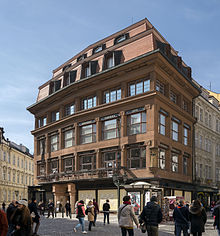
During the 19th century stands therevival architectural styles.Some churches were restored to their presumed medieval appearance and there were constructed buildings in theNeo-Romanesque,Neo-GothicandNeo-Renaissancestyles. At the turn of the 19th and 20th centuries, the new art style appeared in the Czech lands –Art Nouveau.
Bohemia contributed an unusual style to the world's architectural heritage when Czech architects attempted to transpose theCubismof painting and sculpture into architecture.
Between World Wars I and II,Functionalism,with its sober, progressive forms, took over as the main architectural style.[217]
After World War II and the Communist coup in 1948, art in Czechoslovakia became Soviet-influenced. The Czechoslovak avant-garde artistic movement is known as theBrussels stylecame upin the time of political liberalization of Czechoslovakia in the 1960s.Brutalismdominated in the 1970s and 1980s.
The Czech Republic is not shying away from the more modern trends of international architecture, an example is theDancing House (Tančící dům)in Prague,Golden Angelin Prague or Congress Centre in Zlín.[217]
Literature
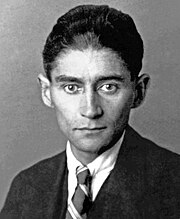
The literature from the area of today's Czech Republic was mostly written in Czech, but also inLatinand German or evenOld Church Slavonic.Franz Kafka,although a competent user of Czech, wrote in his mother tongue, German.[220][221]His works includeThe TrialandThe Castle.
In the second half of the 13th century, the royal court in Prague became one of the centers of GermanMinnesangand courtly literature. The Czech German-language literature can be seen in the first half of the 20th century.
Bible translationsplayed a role in the development of Czech literature. The oldest Czech translation of thePsalmsoriginated in the late 13th century and the first complete Czech translation of the Bible was finished around 1360. The first complete printed Czech Bible was published in 1488. The first complete Czech Bible translation from the original languages was published between 1579 and 1593. TheCodex Gigasfrom the 12th century is the largest extant medieval manuscript in the world.[222]

Czech-language literature can be divided into several periods: the Middle Ages; the Hussite period; theRenaissance humanism;the Baroque period; the Enlightenment and Czech reawakening in the first half of the 19th century, modern literature in the second half of the 19th century; the avant-garde of the interwar period; the years under Communism; and the Czech Republic.
The antiwar comedy novelThe Good Soldier Švejkis the most translated Czech book in history.
The international literary award theFranz Kafka Prizeis awarded in the Czech Republic.[223]
The Czech Republic has the densest network of libraries in Europe.[224]
Czech literature and culture played a role on at least two occasions when Czechs lived under oppression and political activity was suppressed. On both of these occasions, in the early 19th century and then again in the 1960s, the Czechs used their cultural and literary effort to strive for political freedom, establishing a confident, politically aware nation.[225]
Music
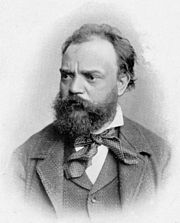
The musical tradition of the Czech lands arose from the first church hymns, whose first evidence is suggested at the break of the 10th and 11th centuries. Some pieces of Czech music include two chorales, which in their time performed the function of anthems: "Lord, Have Mercy on Us"and thehymn"Saint Wenceslaus" or "Saint Wenceslaus Chorale".[226]The authorship of the anthem "Lord, Have Mercy on Us" is ascribed by some historians toSaint Adalbert of Prague(sv.Vojtěch), bishop ofPrague,living between 956 and 997.[227]
The wealth of musical culture lies in the classical music tradition during all historical periods, especially in theBaroque,Classicism,Romantic,modern classicalmusic and in thetraditionalfolk music of Bohemia, Moravia andSilesia.Since the early era of artificial music, Czech musicians and composers have been influenced the folk music of the region and dance.
Czech music can be considered to have been "beneficial" in both the European and worldwide context, several times co-determined or even determined a newly arriving era in musical art,[228]above all ofClassicalera, as well as by original attitudes inBaroque,Romanticandmodern classicalmusic. Some Czech musical works areThe Bartered Bride,New World Symphony,SinfoniettaandJenůfa.
A music festival in the country isPrague Spring International Music Festivalof classical music, a permanent showcase for performing artists, symphony orchestras and chamber music ensembles of the world.
Theatre
The roots of Czech theatre can be found in the Middle Ages, especially in the cultural life of theGothic period.In the 19th century, the theatre played a role in the national awakening movement and later, in the 20th century, it became a part of modern European theatre art. The original Czech cultural phenomenon came into being at the end of the 1950s. This project calledLaterna magika,resulting in productions that combined theater, dance, and film in a poetic manner, considered the firstmultimedia artproject in an international context.
One drama isKarel Čapek's playR.U.R.,which introduced the word "robot".[229]
The country has a tradition ofpuppet theater.In 2016,Czech and Slovak Puppetrywas included on theUNESCO Intangible Cultural Heritage Lists.[230]
Film
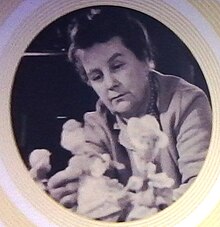
The tradition of Czech cinematography started in the second half of the 1890s. Peaks of the production in the era of silent movies include the historical dramaThe Builder of the Templeand the social and erotic dramaErotikondirected byGustav Machatý.[231]The early Czechsound filmera was productive, above all in mainstream genres, with the comedies ofMartin FričorKarel Lamač.There were dramatic movies sought internationally.[citation needed]
Hermína Týrlováwas a prominent Czech animator, screenwriter, and film director. She was often called the mother of Czech animation. Over the course of her career, she produced over 60 animated children's short films using puppets and the technique of stop motion animation.[citation needed]
Before the German occupation, in 1933, filmmaker and animatorIrena Dodalováestablished the first Czech animation studio "IRE Film" with her husband Karel Dodal.[citation needed]
After the period of Nazi occupation and early communist official dramaturgy of socialist realism in movies at the turn of the 1940s and 1950s with fewer exceptions such asKrakatitorMen without wings(awarded byPalme d'Orin 1946), an era of the Czech film began with animated films, performed in anglophone countries under the name "The Fabulous World of Jules Verne" from 1958, which combined acted drama with animation, andJiří Trnka,the founder of the modern puppet film.[232]This began a tradition of animated films (Moleetc.).
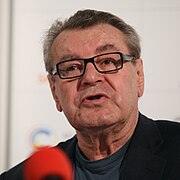
In the 1960s, the hallmark ofCzechoslovak New Wave's films were improviseddialogues,blackandabsurdhumor and the occupation of non-actors. Directors are trying to preserve natural atmosphere without refinement and artificial arrangement of scenes. A personality of the 1960s and the beginning of the 1970s with original manuscript and psychological impact isFrantišek Vláčil.Another international author isJan Švankmajer,a filmmaker and artist whose work spans several media. He is a self-labeledsurrealistknown for animations and features.[233]
TheBarrandov Studiosin Prague are the largest film studios with film locations in the country.[234]Filmmakers have come toPragueto shoot scenery no longer found in Berlin, Paris and Vienna. The city ofKarlovy Varywas used as a location for the 2006 James Bond film Casino Royale.[235]
TheCzech Lionis the highest Czech award for film achievement.Karlovy Vary International Film Festivalis one of the film festivals that have been given competitive status by theFIAPF.Other film festivals held in the country includeFebiofest,Jihlava International Documentary Film Festival,One World Film Festival,Zlín Film FestivalandFresh Film Festival.
Media

Czech journalists and media enjoy a degree offreedom.There are restrictions against writing in support ofNazism,racism or violatingCzech law.The Czech press was ranked as the 40th most free press in the World Press Freedom Index byReporters Without Bordersin 2021.[236]Radio Free Europe/Radio Libertyhas its headquarters in Prague.
Czech Televisionis the country's national public television broadcaster. It operates a number of channels, includingČT1,ČT2,and the 24-hour news channelČT24,as well as the news websitect24.cz.As of 2020, it is the most watched broadcaster, followed by the privateTV NovaandPrima TV.However, TV Nova features the most watched mainnews programandprime timeprogram.[237]Other public media services include theCzech Radioand theCzech News Agency.
The best-selling daily national newspapers in 2020/21 areBlesk(average 703,000 daily readers),Mladá fronta DNES(average 461,000 daily readers),Právo(average 182,000 daily readers),Lidové noviny(average 163,000 daily readers) andHospodářské noviny(average 162,000 daily readers).[238]
Most Czechs (87%[239]) read their news online,[240]withSeznam.cz,iDNES.cz,Novinky.cz,iPrima.czandSeznam Zprávy.czbeing the most visited as of 2021.[241]
Cuisine
This sectionneeds additional citations forverification.(July 2023) |

Czech cuisine is marked by an emphasis on meat dishes with pork, beef, and chicken. Goose, duck, rabbit, and venison are served. Fish is less common, with the occasional exception of freshtroutandcarp,which is served at Christmas.[242][243]One popular Czech menu item issmažený vepřový řízek(fried breaded pork filet), served with boiled potatoes.[244]
There is a variety of local sausages, wurst, pâtés, and smoked and cured meats. Czech desserts include a variety of whipped cream, chocolate, and fruit pastries and tarts, crêpes, creme desserts and cheese, poppy-seed-filled and other types of traditional cakes such asbuchty,koláčeandštrúdl.[245]
Czech beerhas a history extending more than a millennium; the earliest known brewery existed in 993. Today the Czech Republic has the highestbeer consumption per capitain the world. Thepilsnerstyle beer (pils) originated inPlzeň,where the world's first blond lagerPilsner Urquellis still produced. It has served as the inspiration for more than two-thirds of the beer produced in the world today. The city ofČeské Budějovicehas similarly lent its name to its beer, known asBudweiser Budvar.
The South Moravian region has been producingwinesince the Middle Ages; about 94% ofvineyardsin the Czech Republic are Moravian. Aside from beer,slivovitzand wine, the Czech Republic also produces twoliquors,Fernet StockandBecherovka.Kofolais a non-alcoholic domesticcolasoft drink which competes withCoca-ColaandPepsi.
Sport
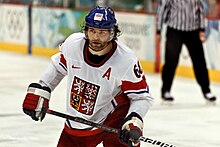
The two leading sports in the Czech Republic arefootballandice hockey.The most watched sporting events are theIce hockey at the Olympic GamesandIce Hockey World Championships.[246][247]Other most popular sports includetennis,volleyball,floorball,golf,ball hockey,athletics,basketballandskiing.[248]
The country has won 15 gold medals in theSummer Olympicsand nine in theWinter Games.(SeeOlympic history.) TheCzech ice hockey teamwon the gold medal at the1998 Winter Olympicsand has won twelve gold medals at theWorld Championships,including three straight from1999to2001.[citation needed]
TheŠkoda Motorsportis engaged incompetition racingsince 1901 and has gained a number of titles with various vehicles around the world.MTXautomobile company was formerly engaged in the manufacture ofracingandformulacars since 1969.[citation needed]
Hikingis a popular sport. The word for 'tourist' in Czech,turista,also means 'trekker' or 'hiker'. For hikers, thanks to the more than 120-year-old tradition, there is theCzech Hiking Markers Systemoftrail blazing,that has been adopted by countries worldwide. There is a network of around 40,000 km of marked short- and long-distance trails crossing the whole country and all the Czech mountains.[249][250]
See also
Explanatory notes
References
- ^"Czech language".Czech Republic – Official website.Ministry of Foreign Affairs of the Czech Republic.Archivedfrom the original on 6 November 2011.Retrieved14 November2011.
- ^abc"Národnost".Census 2021(in Czech).Czech Statistical Office.Archived fromthe originalon 15 January 2022.Retrieved13 January2022.
- ^"Náboženská víra".Census 2021(in Czech).Czech Statistical Office.Archived fromthe originalon 22 January 2022.Retrieved13 January2022.
- ^ab"Land use (as at 31 December)".Public database.Czech Statistical Office.Retrieved11 May2023.
- ^"Population of cohesion regions, regions and districts of the Czech Republic, 1 January 2024".Czech Statistical Office.17 May 2024.
- ^abcd"World Economic Outlook Database, April 2024 Edition. (Czechia)".IMF.org.International Monetary Fund.16 April 2024.Retrieved16 April2024.
- ^"Gini coefficient of equivalised disposable income – EU-SILC survey".ec.europa.eu.Eurostat.Retrieved4 May2024.
- ^"Human Development Report 2023/24"(PDF).United Nations Development Programme.13 March 2024.Retrieved13 March2024.
- ^Citizens belonging to minorities, which traditionally and on a long-term basis live within the territory of the Czech Republic, enjoy the right to use their language in communication with authorities and in courts of law (for the list of recognized minorities seeNational Minorities Policy of the Government of the Czech RepublicArchived7 June 2012 at theWayback Machine,Belarusian and Vietnamese since 4 July 2013, seeČesko má nové oficiální národnostní menšiny. Vietnamce a BělorusyArchived8 July 2013 at theWayback Machine). Article 25 of the CzechCharter of Fundamental Rights and Freedomsensures the right of the national and ethnic minorities to education and communication with the authorities in their own language. Act No. 500/2004 Coll. (The Administrative Rule) in its paragraph 16 (4) (Procedural Language) ensures that a citizen of the Czech Republic who belongs to a national or an ethnic minority, which traditionally and on a long-term basis lives within the territory of the Czech Republic, has the right to address an administrative agency and proceed before it in the language of the minority. If the administrative agency has no employee with knowledge of the language, the agency is bound to obtain a translator at the agency's own expense. According to Act No. 273/2001 (Concerning the Rights of Members of Minorities) paragraph 9 (The right to use language of a national minority in dealing with authorities and in front of the courts of law) the same also applies to members of national minorities in the courts of law.
- ^The Slovak language may be considered an official language in the Czech Republic under certain circumstances, as defined by several laws – e.g. law 500/2004, 337/1992. Source:http://portal.gov.czArchived10 April 2005 at theWayback Machine.Cited: "Například Správní řád (zákon č. 500/2004 Sb.) stanovuje:" V řízení se jedná a písemnosti se vyhotovují v českém jazyce. Účastníci řízení mohou jednat a písemnosti mohou být předkládány i v jazyce slovenském... "(§ 16, odstavec 1). Zákon o správě daní a poplatků (337/1992 Sb.)" Úřední jazyk: Před správcem daně se jedná v jazyce českém nebo slovenském. Veškerá písemná podání se předkládají v češtině nebo slovenštině... "(§ 3, odstavec 1).http://portal.gov.cz
- ^"Oxford English Dictionary".Archivedfrom the original on 11 January 2008.Retrieved13 September2014.
- ^"Publications Office — Interinstitutional style guide — 7.1. Countries — 7.1.1. Designations and abbreviations to use".Publications Office.Archivedfrom the original on 12 April 2023.Retrieved13 October2023.
- ^"the Czech Republic".The United Nations Terminology Database.Archivedfrom the original on 16 June 2023.Retrieved28 November2023.
- ^Šitler, Jiří (12 July 2016)."From Bohemia to Czechia".Czech Radio.Retrieved1 June2021.
- ^"Information about the Czech Republic".Czech Foreign Ministry.Archivedfrom the original on 3 April 2016.Retrieved25 March2016.
- ^Mlsna, Petr; Šlehofer, F.; Urban, D. (2010)."The Path of Czech Constitutionality"(PDF).1st edition(in Czech and English). Praha: Úřad Vlády České Republiky (The Office of the Government of the Czech Republic). pp. 10–11.Archived(PDF)from the original on 16 January 2013.Retrieved31 October2012.
- ^Čumlivski, Denko (2012)."800 let Zlaté buly sicilské"(in Czech). National Archives of the Czech Republic (Národní Archiv České Republiky). Archived fromthe originalon 28 November 2012.Retrieved31 October2012.
- ^Dijk, Ruud van; Gray, William Glenn; Savranskaya, Svetlana; Suri, Jeremi; Zhai, Qiang (2013).Encyclopedia of the Cold War.Routledge. p. 76.ISBN978-1135923112.Archivedfrom the original on 22 November 2018.Retrieved13 December2017.
- ^Timothy Garton AshThe Uses of AdversityGranta Books, 1991ISBN0-14-014038-7p. 60
- ^"Czech definition and meaning".Collins English Dictionary.Collins.Archivedfrom the original on 16 January 2013.Retrieved19 November2012.
- ^"Czech".American Heritage Dictionary.Houghton Mifflin Harcourt.Retrieved24 January2018.
- ^"Czech – Definition in English".Oxford Dictionaries.Oxford University Press. Archived fromthe originalon 12 April 2018.Retrieved11 April2018.
- ^Spal, Jaromír."Původ jména Čech".Naše řeč.Archivedfrom the original on 9 December 2012.Retrieved10 December2012.
- ^Sviták, Zbyněk (2014)."Úvod do historické topografie českých zemí: Územní vývoj českých zemí"(PDF).1st edition(in Czech). Brno. pp. 75–80, 82, 92–96.Archived(PDF)from the original on 9 December 2017.Retrieved23 June2021.
- ^"From Bohemia to Czechia – Radio Prague".12 July 2016.Archivedfrom the original on 9 March 2018.Retrieved11 February2018.
- ^Thompson, Wayne C. (2012).Nordic, Central and Southeastern Europe 2012.Stryker Post. pp. 345–.ISBN978-1-61048-892-1.
- ^"Czechia – the civic initiative".www.czechia-initiative.com.Retrieved11 January2022.
- ^"Vláda schválila doplnení jednoslovného názvu Cesko v cizích jazycích do databází OSN"[The government has approved the addition of one-word Czech name in foreign languages to UN databases].Ministerstvo zahraničních věcí České republiky(in Czech). 5 May 2016.Archivedfrom the original on 28 August 2018.Retrieved28 August2018.
- ^UNGEGN."UNGEGN List of Country Names"(PDF).p. 27.Archived(PDF)from the original on 25 July 2018.
- ^European Union (5 July 2016)."Czechia".European Union.Archivedfrom the original on 25 December 2018.Retrieved31 May2021.
- ^NATO."Member countries".NATO.Retrieved3 October2022.
- ^"Czechia".The World Factbook(2024 ed.).Central Intelligence Agency.Retrieved31 May2021.(Archived 2021 edition.)
- ^"Czechia: mapping progress one year on".Radio Prague International.8 June 2017.Retrieved31 May2021.
- ^"Our Members".European Broadcasting Union. 17 February 2023.Retrieved29 May2023.
- ^@APStylebook (1 July 2022)."We have a new Stylebook Online entry: Czechia, the Czech Republic.Both are acceptable. The shorter name Czechia is…"(Tweet) – viaTwitter.
- ^"Oldest ceramic figurine".Guinness World Records.Retrieved20 May2024.
- ^"Hlava Kelta z Mšeckých Žehrovic – nejcennější keltská plastika v Evropě".Kudyznudy.cz/.Retrieved20 May2024.
- ^Rankin, David (2002).Celts and the Classical World.Routledge. p. 16.ISBN978-1-134-74722-1.
- ^Kartografie Praha (Firm) (1997).Praha, plán města.Kartografie Praha. p. 17.ISBN978-80-7011-468-1.
- ^Vasco La Salvia (2007).Iron Making During the Migration Period: The Case of the Lombards.Archaeopress. p. 43.ISBN978-1-4073-0159-4.
- ^Hugh LeCaine Agnew (2004).The Czechs and the Lands of the Bohemian Crown.Hoover Press. p. 37.ISBN978-0-8179-4492-6.
- ^abHahn, Sylvia; Nadel, Stanley (2014).Asian Migrants in Europe: Transcultural Connections.V&R unipress GmbH. pp. 7–8.ISBN978-3-8471-0254-0.
- ^Bartl, Július; Škvarna, Dušan (2002).Slovak History: Chronology & Lexicon.Bolchazy-Carducci Publishers. p. 18.ISBN978-0-86516-444-4.
- ^Champion, Tim (2005).Centre and Periphery: Comparative Studies in Archaeology.Routledge. p. 233.ISBN978-1-134-80679-9.
- ^Benedetto, Robert; Duke, James O. (2008).The New Westminster Dictionary of Church History: The early, medieval, and Reformation eras.Westminster John Knox Press. p. 474.ISBN978-0-664-22416-5.
- ^Pánek, Jaroslav; Tůma, Oldřich (2019).A History of the Czech Lands.Charles University in Prague, Karolinum Press. p. 76.ISBN978-80-246-2227-9.
- ^Pánek, Jaroslav; Tůma, Oldřich (2019).A History of the Czech Lands.Charles University in Prague, Karolinum Press. p. 111.ISBN978-80-246-2227-9.
- ^Pánek, Jaroslav; Tůma, Oldřich (2019).A History of the Czech Lands.Charles University in Prague, Karolinum Press. p. 237.ISBN978-80-246-2227-9.
- ^Grousset, René (1970).The Empire of the Steppes.Rutgers University Press.p.266.ISBN978-0-8135-1304-1.Retrieved26 August2017.
- ^"Václav II. český král".panovnici.cz.Archivedfrom the original on 7 September 2011.Retrieved31 October2011.
- ^"Mentor and precursor of the Reformation".Archived fromthe originalon 4 April 2016.Retrieved29 April2016.
- ^"Protestantism in Bohemia and Moravia (Czech Republic)".Virtual Museum of Protestantism.Archivedfrom the original on 15 October 2015.Retrieved25 May2015.
- ^Oskar Krejčí, Martin C. Styan, Ústav politických vied SAV. (2005).Geopolitics of the Central European region: the view from Prague and Bratislava.p.293.ISBN80-224-0852-2
- ^"RP's History Online – Habsburgs".Archiv.radio.cz. Archived fromthe originalon 17 July 2011.Retrieved25 April2010.
- ^"History of the Mongols from the 9th to the 19th Century. Part 2. The So-Called Tartars of Russia and Central Asia. Division 1".Henry Hoyle Howorth. p.557.ISBN1-4021-7772-0
- ^"The new Cambridge modern history: The ascendancy of France, 1648–88".Francis Ludwig Carsten (1979). p.494.ISBN0-521-04544-4
- ^"The Cambridge economic history of Europe: The economic organization of early modern Europe".E. E. Rich, C. H. Wilson, M. M. Postan (1977). p.614.ISBN0-521-08710-4
- ^Hlavačka, Milan (2009). "Formování moderního českého národa 1815–1914".Historický Obzor(in Czech).20(9/10): 195.
- ^abCole, Laurence; Unowsky, David (eds.).The Limits of Loyalty: Imperial Symbolism, Popular Allegiances, and State Patriotism in the Late Habsburg Monarchy(PDF).New York, Oxford: Berghahn Books. Archived fromthe original(PDF)on 25 May 2015.Retrieved24 May2015.
- ^"Františka Plamínková: the feminist suffragette who ensured Czechoslovakia's Constitution of 1920 lived up to the principle of equality".Radio Prague International.29 February 2020.Retrieved5 January2021.
- ^abStephen J. Lee.Aspects of European History 1789–1980.Page 107. Chapter "Austria-Hungary and the successor states".Routledge.28 January 2008.
- ^Preclík, Vratislav. Masaryk a legie (Masaryk and legions), váz. kniha, 219 pages, first issue – vydalo nakladatelství Paris Karviná, Žižkova 2379 (734 01 Karviná, Czech Republic) ve spolupráci s Masarykovým demokratickým hnutím (Masaryk Democratic Movement, Prague), 2019,ISBN978-80-87173-47-3,pages 22–81, 85–86, 111–112, 124–125, 128, 129, 132, 140–148, 184–209.
- ^"Tab. 3 Národnost československých státních příslušníků podle žup a zemí k 15 February 1921"(PDF)(in Czech).Czech Statistical Office.Archived fromthe original(PDF)on 5 June 2007.Retrieved2 June2007.
- ^"Ekonomika ČSSR v letech padesátých a šedesátých".Blisty.cz. 21 August 1968.Archivedfrom the original on 7 July 2014.Retrieved14 May2014.
- ^Dijk, Ruud van; Gray, William Glenn; Savranskaya, Svetlana; Suri, Jeremi; Zhai, Qiang (2013).Encyclopedia of the Cold War.Routledge. p. 76.ISBN978-1135923112.Archivedfrom the original on 22 November 2018.Retrieved13 December2017.
- ^Rothenbacher, Franz (2002).The European Population 1850–1945.Palgrave Macmillan, London. p. 145.ISBN978-1-349-65611-0.
- ^Chad Bryant(2009)Prague in Black: Nazi Rule and Czech Nationalism(Harvard University Press, 2009), pp 104–178.Snyder, Timothy(2010).Bloodlands: Europe Between Hitler and Stalin.Basic Books. p. 160.ISBN0465002390
- ^"A Companion to Russian HistoryArchived6 September 2015 at theWayback Machine".Abbott Gleason (2009). Wiley-Blackwell. p.409.ISBN1-4051-3560-3
- ^Chad Bryant(2009)Prague in Black: Nazi Rule and Czech Nationalism(Harvard University Press, 2009), 208–252.
- ^F. Čapka:Dějiny zemí Koruny české v datechArchived20 June 2008 at theWayback Machine.XII. Od lidově demokratického po socialistické Československo – pokračování. Libri.cz(in Czech)
- ^"Czech schools revisit communism".Archivedfrom the original on 4 August 2014.Retrieved13 September2014.
- ^Velinger, Jan (28 February 2006)."World Bank Marks Czech Republic's Graduation to 'Developed' Status".Radio Prague.Archivedfrom the original on 12 January 2008.Retrieved22 January2007.
- ^"Human Development Report 2009"(PDF).UNDP.org.January 2009.Archived(PDF)from the original on 22 November 2009.Retrieved25 April2010.
- ^"EU, NATO, Schengen and Eurozone member states in Europe".13 October 2018.
- ^"Czech election: Billionaire Babis wins by large margin".BBC News.21 October 2017.
- ^"Czech billionaire Andrej Babis named new prime minister".Deutsche Welle.6 December 2017.
- ^"Czech Republic: Petr Fiala named new prime minister".DW.COM.28 November 2021.
- ^"Retired general Petr Pavel wins election to become Czech president".euronews.28 January 2023.
- ^"Regional Refugee Response Plan for the Ukraine Situation – Inter-Agency Operational Update: Czech Republic, July – October 2022".reliefweb.UN Office for the Coordination of Humanitarian Affairs. 17 November 2022.Retrieved25 February2023.
- ^Field, Matt."Ukraine is fighting on behalf of all democracies".GOV.UK.British Embassy Prague.Retrieved25 February2023.
- ^Dinerstein, Eric; Olson, David; Joshi, Anup; Vynne, Carly; Burgess, Neil D.; Wikramanayake, Eric; Hahn, Nathan; Palminteri, Suzanne; Hedao, Prashant; Noss, Reed; Hansen, Matt; Locke, Harvey; Ellis, Erle C; Jones, Benjamin; Barber, Charles Victor; Hayes, Randy; Kormos, Cyril; Martin, Vance; Crist, Eileen; Sechrest, Wes; Price, Lori; Baillie, Jonathan E. M.; Weeden, Don; Suckling, Kierán; Davis, Crystal; Sizer, Nigel; Moore, Rebecca; Thau, David; Birch, Tanya; Potapov, Peter; Turubanova, Svetlana; Tyukavina, Alexandra; de Souza, Nadia; Pintea, Lilian; Brito, José C.; Llewellyn, Othman A.; Miller, Anthony G.; Patzelt, Annette; Ghazanfar, Shahina A.; Timberlake, Jonathan; Klöser, Heinz; Shennan-Farpón, Yara; Kindt, Roeland; Lillesø, Jens-Peter Barnekow; van Breugel, Paulo; Graudal, Lars; Voge, Maianna; Al-Shammari, Khalaf F.; Saleem, Muhammad (2017)."An Ecoregion-Based Approach to Protecting Half the Terrestrial Realm".BioScience.67(6): 534–545.doi:10.1093/biosci/bix014.ISSN0006-3568.PMC5451287.PMID28608869.
- ^R. Tolasz,Climate Atlas of the Czech Republic,Czech Hydrometeorological Institute, Prague, 2007.ISBN80-244-1626-3,graphs 1.5 and 1.6
- ^"Czech absolute record temperature registered near Prague".České noviny.ČTK.Archivedfrom the original on 25 October 2012.Retrieved20 August2012.
- ^R. Tolasz,Climate Atlas of the Czech Republic,Czech Hydrometeorological Institute, Prague, 2007.ISBN80-244-1626-3,graph 2.9.
- ^Brázdil, Rudolf; et al. (2019). "Spatiotemporal variability of tornadoes in the Czech Lands, 1801–2017".Theor. Appl. Climatol.136(3–4): 1233–1248.Bibcode:2019ThApC.136.1233B.doi:10.1007/s00704-018-2553-y.S2CID126348854.
- ^Antonescu, Bogdan; D. M. Schultz; F. Lomas (2016)."Tornadoes in Europe: Synthesis of the Observational Datasets".Mon. Wea. Rev.144(7): 2445–2480.Bibcode:2016MWRv..144.2445A.doi:10.1175/MWR-D-15-0298.1.
- ^"Country Rankings".Yale. 2016. Archived fromthe originalon 2 February 2016.Retrieved21 November2016.
- ^Grantham, H. S.; Duncan, A.; Evans, T. D.; Jones, K. R.; Beyer, H. L.; Schuster, R.; Walston, J.; Ray, J. C.; Robinson, J. G.; Callow, M.; Clements, T.; Costa, H. M.; DeGemmis, A.; Elsen, P. R.; Ervin, J.; Franco, P.; Goldman, E.; Goetz, S.; Hansen, A.; Hofsvang, E.; Jantz, P.; Jupiter, S.; Kang, A.; Langhammer, P.; Laurance, W. F.; Lieberman, S.; Linkie, M.; Malhi, Y.; Maxwell, S.; Mendez, M.; Mittermeier, R.; Murray, N. J.; Possingham, H.; Radachowsky, J.; Saatchi, S.; Samper, C.; Silverman, J.; Shapiro, A.; Strassburg, B.; Stevens, T.; Stokes, E.; Taylor, R.; Tear, T.; Tizard, R.; Venter, O.; Visconti, P.; Wang, S.; Watson, J. E. M. (2020)."Anthropogenic modification of forests means only 40% of remaining forests have high ecosystem integrity – Supplementary Material".Nature Communications.11(1): 5978.Bibcode:2020NatCo..11.5978G.doi:10.1038/s41467-020-19493-3.ISSN2041-1723.PMC7723057.PMID33293507.
- ^"The Constitution of the Czech Republic – Article 16".Czech Republic.Archivedfrom the original on 3 September 2015.Retrieved8 August2015.
- ^"Klaus signs Czech direct presidential election implementing law".Czech Press Agency. 1 August 2012.Archivedfrom the original on 16 January 2013.Retrieved7 November2012.
- ^Hloušek, Vít (11 March 2015)."Is the Czech Republic on its Way to Semi-Presidentialism?".Baltic Journal of Law & Politics.7(2): 95–118.doi:10.1515/bjlp-2015-0004.
- ^"Members of the Government".Government of the Czech Republic.Archivedfrom the original on 31 August 2015.Retrieved8 August2015.
- ^"Prime Minister".Government of the Czech Republic.Archivedfrom the original on 4 March 2016.Retrieved8 August2015.
- ^Cabada, Ladislav; Waisová, Šárka (2011).Czechoslovakia and the Czech Republic in World Politics.Lexington Books. p. 18.ISBN978-0-7391-6733-5.
- ^abcdKuklík, Jan (2015).Czech Law in Historical Contexts.Charles University in Prague, Karolinum Press. pp. 221–234.ISBN978-80-246-2860-8.
- ^"Global Peace Index 2020"(PDF).visionofhumanity.org.Institute for Economics and Peace.Archived(PDF)from the original on 9 October 2022.
- ^"The Czech Republic's Membership in International Organizations".United States State Department.Retrieved8 August2015.
- ^"The Henley & Partners Visa Restrictions Index 2018. Data accurate as of 16 January 2018"(PDF).Archived(PDF)from the original on 9 May 2018.Retrieved13 March2018.
- ^"Visa Openness Report 2016"(PDF).World Tourism Organization. Archived fromthe original(PDF)on 23 January 2016.Retrieved17 January2016.
- ^"About the Visegrad Group".Visegrád Group.15 August 2006.Archivedfrom the original on 17 July 2015.Retrieved8 August2015.
- ^"Společné prohlášení ke strategickému dialogu mezi Ministerstvem zahraničních věcí České republiky a Ministerstvem zahraničních věcí Spolkové republiky Německo jako novém rámci pro česko-německé vztahy"(PDF).German embassy in the Czech Republic. Archived fromthe original(PDF)on 3 September 2015.Retrieved8 August2015.
- ^"Czech Vote Against Palestine: Only European Nation At UN To Vote Against Palestinian State Was Czech Republic".The Huffington Post.30 November 2012.Archivedfrom the original on 24 September 2015.Retrieved8 August2015.
- ^"Czech-U.S. Relations".Ministry of Foreign Affairs of the Czech Republic.Archivedfrom the original on 15 October 2015.Retrieved8 August2015.
- ^"Programové prohlášení vlády".Vlada.cz(in Czech).Retrieved30 March2023.
- ^"Rusko zveřejnilo seznam nepřátelských zemí. Jsou na něm jen dvě: Česko a USA"(in Czech). Aktuálně.cz. 14 May 2021.Retrieved30 March2023.
- ^"Czechs with few mates".The Economist.30 August 2007.Archivedfrom the original on 25 September 2009.Retrieved8 August2015.
- ^"Resortní rozpočet".Ministry of Defence of the Czech Republic.Archivedfrom the original on 2 August 2015.Retrieved8 August2015.
- ^"Foreign Operations".Ministry of Defence of the Czech Republic.Archivedfrom the original on 6 March 2016.Retrieved25 March2016.
- ^"Diskriminace Romů v českých školách jako evropský problém".1 April 2016. Archived fromthe originalon 1 April 2016.Retrieved15 November2022.
- ^"Evropská komise žádá Česko o data kvůli diskriminaci Romů ve školách".iDNES.cz(in Czech). 25 September 2014.Retrieved15 November2022.
- ^"Evropský soud tlačí vládu k odškodnění za nedobrovolné sterilizace romských žen".llp.cz.Liga lidských práv. 2 April 2016. Archived fromthe originalon 2 April 2016.Retrieved15 November2022.
- ^"Vláda: Litujeme nezákonných sterilizací romských žen".Lidovky.cz(in Czech). 23 November 2009.Retrieved15 November2022.
- ^Lopatka, Jan; Hovet, Jason."Czech lawmakers give first nod to same-sex marriage bill, opposition ahead".Reuters.Retrieved19 August2023.
- ^"The death of the districts".3 January 2003.Archivedfrom the original on 15 February 2010.Retrieved13 September2014.
- ^Mccanndigital.cz."Getting to know Czech Republic".Archivedfrom the original on 19 July 2014.Retrieved13 September2014.
- ^"World Bank 2007".Web.worldbank.org. Archived fromthe originalon 24 May 2008.Retrieved25 April2010.
- ^Aspalter, Christian; Jinsoo, Kim; Sojeung, Park (2009)."Analysing the Welfare State in Poland, the Czech Republic, Hungary and Slovenia: An Ideal-Typical Perspective".Social Policy & Administration.43(2): 170–185.doi:10.1111/j.1467-9515.2009.00654.x.
- ^"GDP per capita in PPS".Eurostat.Archivedfrom the original on 24 May 2015.Retrieved16 June2015.
- ^Tait, Robert (6 January 2019)."Czech democracy 'under threat' from rising debt crisis".The Guardian.
- ^"World Economic Outlook Database, April 2019".IMF.org.International Monetary Fund.Retrieved4 June2019.
- ^"World Economic Outlook Database, April 2019".IMF.org.International Monetary Fund.Retrieved24 April2019.
- ^Brandmeir, Kathrin; Grimm, Michaela; Heise, Michael; Holzhausen, Arne."Allianz Global Wealth Report 2018"(PDF).Archived(PDF)from the original on 9 October 2022.Retrieved25 January2021.
- ^"Česká ekonomika na konci roku dál rostla, HDP loni stoupl o 4,5 procenta".iDNES.cz(in Czech). 16 February 2018.Archivedfrom the original on 15 March 2018.Retrieved14 March2018.
- ^Unemployment rates, seasonally adjusted, September 2016Archived28 December 2017 at theWayback Machine.Eurostat.
- ^Federica Cocco.Israel and the US have the highest poverty rates in the developed worldArchived28 December 2017 at theWayback Machine.Financial Times.Published on 19 October 2016.
- ^"Country Rankings: World & Global Economy Rankings on Economic Freedom".www.heritage.org.Archivedfrom the original on 24 November 2018.Retrieved15 March2018.
- ^WIPO."Global Innovation Index 2023, 15th Edition".www.wipo.int.doi:10.34667/tind.46596.Retrieved23 October2023.
- ^"The Global Innovation Index 2016".The Global Innovation Index. 2016. Archived fromthe originalon 2 February 2017.Retrieved31 January2019.
- ^"The Global Competitiveness Report 2018".Archivedfrom the original on 17 October 2018.Retrieved17 October2018.
- ^"Enabling Trade rankings".Archivedfrom the original on 21 March 2018.Retrieved15 March2018.
- ^Economic Complexity Rankings (ECI)Archived14 March 2018 at theWayback Machine.The Atlas of Economic Complexity.Access date 3 October 2017.
- ^LABOR FORCE – BY OCCUPATIONArchived22 May 2014 at theWayback Machine.The World Factbook.
- ^"Czech foreign owned companies take second biggest dividend yield in 2017:report".Radio Prague.7 March 2018.
- ^"Czech Republic to join Schengen".The Prague Post. 13 December 2006. Archived fromthe originalon 25 February 2008.Retrieved8 October2007.
- ^"100 Nejvýznamnějších".CZECH TOP 100(in Czech).Retrieved1 July2019.
- ^"Tramvaje firmy Pragoimex: česká klasika v novém kabátě".Euro.cz(in Czech). 16 December 2008.Archivedfrom the original on 14 April 2018.Retrieved13 April2018.
- ^"Zlaté české ručičky. V tomhle jsme nejlepší, i když se o tom skoro neví".ČtiDoma.cz(in Czech). 11 April 2018.Archivedfrom the original on 13 April 2018.Retrieved13 April2018.
- ^"Příběh firmy Česká zbrojovka: kde se rodí pistole".E15.cz.
- ^"'V lednu ani kubík.' Dovoz plynu z Ruska do Česka klesl na nulu, uvedl Síkela ".iROZHLAS(in Czech). 18 February 2023.Retrieved30 March2023.
- ^"Transport Yearbook 2020: 3.2.1. Road transport infrastructure".Ministry of Transport.Retrieved24 November2021.
- ^"Going abroad – Czech Republic".ec.europa.eu.Archivedfrom the original on 3 October 2018.Retrieved3 October2018.
- ^"Transport Yearbook 2020: 3.1.2. Lines".Ministry of Transport.Retrieved24 November2021.
- ^"Transport Yearbook 2020: 3.1.1. Tracks".Ministry of Transport.Retrieved24 November2021.
- ^"Letiště"(in Czech). Ministry of Transport.Retrieved24 November2021.
- ^"Transport Yearbook 2020: 3.4. Air transport infrastructure".Ministry of Transport.Retrieved24 November2021.
- ^"Letišť má Česko až moc, většinou jsou ztrátová"(in Czech). Novinky.cz. 21 August 2019.Retrieved24 November2021.
- ^Vlček, Pavel (14 November 2010)."Minister Kocourek launches the Gazela gas pipeline linking the Czech Republic to Nord Stream".Ministry of Industry and Trade.Retrieved15 January2019.
- ^Taylor, Lee (2 May 2012)."'State of the Internet' report reveals the fastest web speeds around the world ".news.com.au.Archivedfrom the original on 2 May 2012.Retrieved2 May2012.
- ^"Wi-Fi: Poskytovatelé bezdrátového připojení".internetprovsechny.cz. Archived fromthe originalon 8 March 2008.Retrieved17 March2008.
- ^"Bezdrátové připojení k internetu".bezdratovepripojeni.cz.Archivedfrom the original on 23 June 2008.Retrieved18 May2008.
- ^"Antivirus giant Avast is acquiring rival AVG for $1.3b".TNW. 7 July 2016.Archivedfrom the original on 12 June 2018.Retrieved18 June2018.
- ^"Avast not done with deal-making after AVG buy, but no rush".Reuters.30 September 2016.Archivedfrom the original on 16 October 2017.Retrieved2 July2017.
- ^"Avast Buys Piriform, the Company Behind CCleaner and Recuva".BleepingComputer.Archivedfrom the original on 20 July 2017.Retrieved5 March2018.
- ^Bremner, Caroline (2015)."Top 100 City Destinations Ranking".Euromonitor International.Archivedfrom the original on 28 June 2015.Retrieved9 February2015.
- ^"Promotion Strategy of the Czech Republic in 2004–2010".Czech Tourism. Archived fromthe originalon 28 March 2007.Retrieved19 December2006.
- ^"Prague sees significant dip in tourist numbers".Radio.cz. 21 April 2010.Archivedfrom the original on 3 April 2009.Retrieved25 April2010.
- ^ab"Prague mayor goes undercover to expose the great taxi rip-off".The Independent.Archivedfrom the original on 5 September 2011.Retrieved13 September2014.
- ^"Tips on Staying Safe in Prague".Archivedfrom the original on 23 September 2014.Retrieved13 September2014.
- ^"Czech Republic – Country Specific Information".Archived fromthe originalon 17 December 2013.Retrieved13 September2014.
- ^"Tentative Lists".UNESCO.Retrieved13 March2024.
- ^"Czech Republic Travel Guide – Tourist Information and Guide to Czech Republic".www.travelguidepro.com.Archivedfrom the original on 23 August 2018.Retrieved10 January2018.
- ^"Czech Science: Past, Present, and Future".connect.ceitec.cz/.Ceitec Connect.Retrieved1 June2021.
- ^"Czech Footprint: Inventions and Inventors".www.skoda-storyboard.com/.16 November 2018.Retrieved1 June2021.
- ^"National Artificial Intelligence Strategy of the Czech Republic"(PDF).www.mpo.cz.Ministry of Industry and Trade.Archived(PDF)from the original on 9 October 2022.Retrieved1 June2021.
- ^"Research and Development in the Czech Republic".www.czechinvest.org/en.Czech Invest.Retrieved1 June2021.
- ^"Best Global Universities in the Czech Republic".www.usnews.com.U.S. News & World Report.Retrieved1 June2021.
- ^"Research News".gacr.cz/en.Grantová agentura České republiky.Retrieved1 June2021.
- ^"Exhibition traces Czech contribution to finding Amazon River source".www.czech.radio.Radio Prague International. 28 May 2021.Retrieved1 June2021.
- ^"The Czech Republic, home of robotics".ec.europa.eu.19 June 2012.Retrieved1 June2021.
- ^"World success of Czech scientists: A breakthrough method can help in the treatment of Alzheimer's disease or cancer".imtm.cz.Institute of Molecular and Translational Medicine. Archived fromthe originalon 2 June 2021.Retrieved1 June2021.
- ^"Czech and Slovak Freedom Lecture: The Role of Czech and International Scientists in the Fight Against the Pandemic".www.wilsoncenter.org.The Wilson Center.Retrieved1 June2021.
- ^"Global Innovation Index 2021".World Intellectual Property Organization.United Nations.Retrieved5 March2022.
- ^"Release of the Global Innovation Index 2020: Who Will Finance Innovation?".wipo.int.Retrieved2 September2021.
- ^"Global Innovation Index 2019".wipo.int.Retrieved2 September2021.
- ^"The Czech Academy of Sciences".www.avcr.cz.The Czech Academy of Sciences.Retrieved1 June2021.
- ^"Czech Made".www.czech.radio.Radio Prague International. 19 January 2021.Retrieved1 June2021.
- ^"Czechoslovak Society of Arts & Sciences".svu2000.org.Společnost pro vědy a umění.Retrieved1 June2021.
- ^"All Nobel Prizes".NobelPrize.org.Retrieved2 June2021.
- ^"Sigmund Freud | Biography, Theories, Works, & Facts".Encyclopedia Britannica.Retrieved2 June2021.
- ^Klein, Paul, ed. (2013).Solitude of a Humble Genius-- Gregor Johann Mendel. Volume 1, Formative years.Berlin: Springer.ISBN978-3-642-35254-6.OCLC857364787.
- ^Klicperová-Baker, M.; Hoskovcová, S.; Heller, D. (2020). "Psychology in the Czech lands: Bohemia, Czechoslovakia, and the Czech Republic".International Journal of Psychology.55(2): 133–143.doi:10.1002/ijop.12607.PMID31304980.S2CID196613980.
- ^"Research and Innovation Ranking".www.scimagoir.com.Scimago Institutions Rankings.Retrieved1 June2021.
- ^"Population change – year 2015".Population change – year 2015.
- ^"The World FactBook – Czechia",The World Factbook,18 November 2021
- ^"Czechia".The World Factbook(2024 ed.).Central Intelligence Agency.Retrieved14 May2014.(Archived 2014 edition.)
- ^"Press: Number of foreigners in ČR up ten times since 1989".Prague Monitor. 11 November 2009.
- ^O'Connor, Coilin (29 May 2007)."Is the Czech Republic's Vietnamese community finally starting to feel at home?".Czech Radio.Archivedfrom the original on 13 January 2008.Retrieved1 February2008.
- ^Bilefsky, Dan (6 June 2009)."Crisis Strands Vietnamese Workers in a Czech Limbo".The New York Times.Archivedfrom the original on 25 March 2014.Retrieved13 September2014.
- ^"Foreigners working in the Czech Republic".Ministry of Foreign Affairs. July 2006. Archived fromthe originalon 3 June 2009.Retrieved3 June2009.
- ^"The History and Origin of the Roma".Romove.radio.cz.Archivedfrom the original on 25 April 2010.Retrieved25 April2010.
- ^Green, Peter S. (5 August 2001)."British Immigration Aides Accused of Bias by Gypsies".The New York Times.Archivedfrom the original on 11 November 2012.Retrieved25 April2010.
- ^"Jarosław Jot-Drużycki: Poles living in Zaolzie identify themselves better with CzechsArchived26 April 2018 at theWayback Machine".European Foundation of Human Rights.3 September 2014.
- ^"R01 Cizinci v ČR v letech 2004 – 2021 (stav k 31. 12.)".Czech Statistical Office.Retrieved21 March2023.
- ^Foreigners in the Czech Republic – 2017.Prague: Czech Statistical Office. 2017.ISBN978-80-250-2781-3.
- ^"The Holocaust in Bohemia and Moravia".Ushmm.org.Archivedfrom the original on 5 August 2009.Retrieved25 April2010.
- ^"The Virtual Jewish Library".Archivedfrom the original on 21 June 2010.Retrieved13 September2014.
- ^"PM Fischer visits IsraelArchived25 July 2009 at theWayback Machine".Radio Prague. 22 July 2009.
- ^"První výsledky Sčítání 2021"(PDF).Czech Statistical Office.Archived(PDF)from the original on 9 October 2022.Retrieved13 January2022.
- ^"Všechny tabulky - sldb2021_pv_tabulky.xlsx".Czech Statistical Office.Retrieved13 January2022.
- ^"Population of Municipalities – 1 January 2023".Czech Statistical Office.23 May 2023.
- ^ab"Population by religious belief and by municipality size groups"(PDF).Czech Statistical Office. Archived fromthe original(PDF)on 21 February 2015.Retrieved23 April2012.
- ^"End of year 2014 – Czech Republic"(PDF).Wingia.com.Archived fromthe original(PDF)on 9 March 2017.Retrieved5 January2018.
- ^"NÁBOŽENSKÁ VÍRA OBYVATEL PODLE VÝSLEDKŮ SČÍTÁNÍ LIDU".Czech Statistical Office. 27 February 2014.Archivedfrom the original on 13 May 2018.Retrieved27 December2017.
Chapter 1. "Změny struktury obyvatel podle náboženské víry v letech 1991, 2001 a 2011"; table "Struktura obyvatel podle náboženské víry (náboženského vyznání) v letech 1991 – 2011": believers 20,8%; non-believers 34,5%; no declared religion 44,7%
- ^Global Index of Religion and AtheismArchived26 December 2017 at theWayback MachinePress ReleaseArchived21 October 2013 at theWayback Machine.2012. secularpolicyinstitute.net
- ^Richard Felix Staar,Communist regimes in Eastern Europe,Issue 269, p. 90
- ^Spousta, Jan (2002)."Changes in Religious Values in the Czech Republic"(PDF).Czech Sociological Review.38(3): 345–363.doi:10.13060/00380288.2002.38.3.06.Archived fromthe original(PDF)on 1 November 2021.
- ^"Czechia".World Jewish Congress.Retrieved16 May2022.
- ^TheCzechoslovak Hussite Churchcontains mixed Protestant, Catholic, Eastern Orthodox and national elements. Classifying it as either one is disputable. For more details and dispute about this, seeCzechoslovak Hussite Church.
- ^"Population by denomination and sex: as measured by 1921, 1930, 1950, 1991 and 2001 censuses"(PDF)(in Czech and English). Czech Statistical Office.Archived(PDF)from the original on 21 February 2011.Retrieved9 March2010.
- ^"Europe's Growing Muslim Population".Pew Research Center.29 November 2017.Retrieved16 May2022.
- ^"Data za poměrové ukazatele – sldb2021".Czech Statistical Office.Retrieved13 January2022.
- ^abMeschi, Elena; Scervini, Francesco (10 December 2013)."Expansion of schooling and educational inequality in Europe: the educational Kuznets curve revisited".Oxford Economic Papers.66(3): 660–680.doi:10.1093/oep/gpt036.Archivedfrom the original on 24 November 2016.
- ^"Range of rank on the PISA 2006 science scale"(PDF).OECD.org.Archived(PDF)from the original on 29 December 2009.Retrieved25 April2010.
- ^"Education index | Human Development Reports".hdr.undp.org.Archived fromthe originalon 4 January 2018.
- ^Holcik, J; Koupilova, I (2000)."Primary health care in the Czech Republic: brief history and current issues".Int J Integr Care.1:e06.doi:10.5334/ijic.8.PMC1534002.PMID16902697.
- ^"Euro Health Consumer Index 2016"(PDF).Health Consumer Powerhouse. Archived fromthe original(PDF)on 14 October 2017.Retrieved8 April2017.
- ^abcd"History of Czech Architecture".eu2009.cz.Czech Presidency of the European Union.Archivedfrom the original on 15 October 2015.Retrieved20 July2015.
- ^"The History of Architecture".www.czech.cz.Archivedfrom the original on 23 September 2015.Retrieved18 August2015.
- ^Kotalík, Jiří (2002).Architektura barokní(in Czech) (Deset století architektury ed.). Prague: Správa Pražského hradu a DaDa. p. 13.ISBN978-80-86161-38-9.
- ^Hawes, James(2008).Why You Should Read Kafka Before You Waste Your Life.New York: St. Martin's Press. p. 29.ISBN978-0-312-37651-2.
- ^Sayer, Derek (1996)."The Language of Nationality and the Nationality of Language: Prague 1780–1920".Past and Present.153(1). Oxford: 164–210.doi:10.1093/past/153.1.164.OCLC394557.Archived fromthe originalon 7 April 2020.Retrieved25 January2021.
- ^"Codex Gigas: The Devil's Bible".Prague Post.19 October 2005.Retrieved5 January2021.
- ^"Společnost Franze Kafky – Cena Franze Kafky".www.franzkafka-soc.cz.Archivedfrom the original on 13 January 2017.Retrieved9 February2017.
- ^Patterson, Dave (21 July 2016)."The Czech Republic Has The Densest Library Network In The World".Archivedfrom the original on 11 February 2017.Retrieved9 February2017.
- ^Abrams, Bradley F. (2005).The Struggle for the Soul of the Nation: Czech Culture and the Rise of Communism.Rowman & Littlefield.ISBN978-0-7425-3024-9.
- ^The chronicles of Beneš Krabice of Veitmil – the hymn "Svatý Václave" mentioned there as old and well-known at the end of the 13th century[1]Archived5 March 2012 at theWayback Machine
- ^Dějiny české hudby v obrazech (History of Czech music in pictures); in Czech
- ^"Czech Music".27 June 2007.Archivedfrom the original on 2 January 2016.Retrieved3 January2016.
- ^"The Origin Of The Word 'Robot'".Science Friday.Retrieved5 January2021.
- ^"Puppetry in Slovakia and Czechia".UNESCO.Retrieved29 November2021.
- ^"Gustav Machatý's Erotikon (1929) & Ekstase (1933): Cinema's Earliest Explorations of Women's Sensuality".Open Culture.Archivedfrom the original on 25 January 2016.Retrieved8 January2016.
- ^"History of Czech cinematography".Archivedfrom the original on 28 January 2016.Retrieved8 January2016.
- ^Solomon, Charles (19 July 1991)."Brooding Cartoons From Jan Svankmajer".LA Times.Archivedfrom the original on 15 July 2012.Retrieved24 August2010.
- ^"KFTV".Wilmington Publishing and Information Ltd.Archivedfrom the original on 16 January 2013.Retrieved26 October2012.
- ^"Czech Film Commission – Karlovy Vary".Czech Film Commission. Archived fromthe originalon 16 January 2013.Retrieved26 October2012.
- ^"2021 World Press Freedom Index".Reporters Without Borders.Retrieved30 November2021.
- ^"Pro ČT byl rok 2020 rokem rekordů, Nova kralovala sledovanosti"(in Czech). iDnes. 5 January 2021.Retrieved30 November2021.
- ^"Kdo vlastní v Česku noviny? Babiš, Křetinský, Bakala a další"(in Czech). Finance.cz. 2 July 2021.Retrieved30 November2021.
- ^"Digital News Report: Češi získávají zprávy z internetu a TV, věří ČT a ČRo".MediaGuru.cz(in Czech).Retrieved15 January2022.
- ^"Digital News Report 2021".Reuters Institute for the Study of Journalism.Retrieved15 January2022.
- ^"Online data (OLA) | SPIR".netmonitor.cz.Retrieved15 January2022.
- ^Purkrábek, Jan (24 December 2020)."Why do Czechs eat carp for Christmas?".Expats.cz.Howlings s.r.o.Retrieved25 February2023.
- ^"Czech Food and Drink".myCzechRepublic.Local Lingo s.r.o.Retrieved25 February2023.
- ^Roberts, Andrew (2005)."řízek." From Good King Wenceslaus to the Good Soldier Švejk: A Dictionary of Czech Popular Culture.Budapest, Hungary: Central European University Press. p. 143.ISBN978-1-4237-3585-4.
- ^Čiháková, Jana."Hledá se skutečně český dezert. Uhádnete, který to je?".CZ TEST.Granville.Retrieved25 February2023.
- ^"ČT sport vysílá deset let, nejsledovanější byl hokej".MediaGuru.cz(in Czech).Archivedfrom the original on 7 May 2018.Retrieved6 May2018.
- ^"Prague's Most Popular Sports".Prague.fm. 21 October 2011.Archivedfrom the original on 13 April 2014.Retrieved14 May2014.
- ^"Golf, florbal a hokejbal pronikly mezi nejoblíbenější české sporty".iDNES.cz.11 October 2009.
- ^"Hiking in the Czech Republic".Expats. 16 June 2011.Archivedfrom the original on 23 October 2016.Retrieved23 October2016.
- ^"Turistické značení KČT".KČT.Archivedfrom the original on 15 February 2017.Retrieved23 October2016.
Further reading
- Angi, János (1997). "A nyugati szláv államok" [Western Slavic states]. In Pósán, László; Papp, Imre; Bárány, Attila; Orosz, István; Angi, János (eds.).Európa a korai középkorban[Europe in the Early Middle Ages] (in Hungarian). Multiplex Media – Debrecen University Press. pp. 358–365.ISBN978-963-04-9196-9.
- Bryant, Chad (2021).Prague: Belonging and the Modern City.Cambridge, MA: Harvard University Press.ISBN9780674048652.
- Hochman, Jiří (1998).Historical Ddictionary of the Czech State.Lanham, Md. and London: The Scarecrow Press.ISBN0810833387.
External links
- Governmental website
- Presidential website
- Senate
- Portal of the Public Administration
- #VisitCzechia– official tourist portal of the Czech Republic
- Czechia–Central Intelligence Agency:The World Factbook
 Wikimedia Atlas of the Czech Republic
Wikimedia Atlas of the Czech Republic Geographic data related toCzech RepublicatOpenStreetMap
Geographic data related toCzech RepublicatOpenStreetMap
- Czech Republic
- Central Europe
- Countries in Europe
- Landlocked countries
- Member states of NATO
- Member states of the European Union
- Member states of the United Nations
- Member states of the Three Seas Initiative
- Republics
- Member states of the Council of Europe
- OECD members
- States and territories established in 1993



